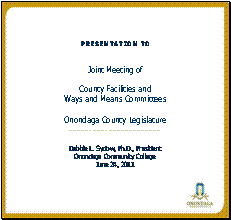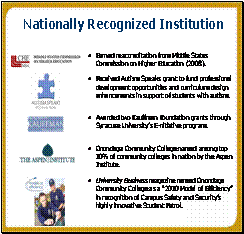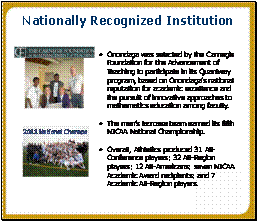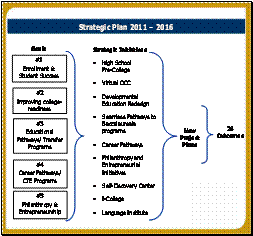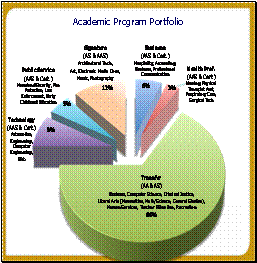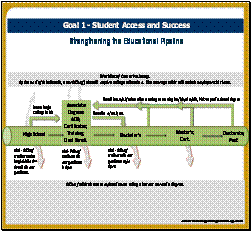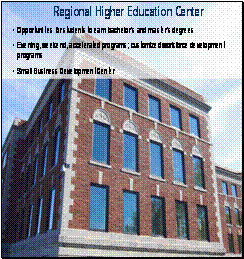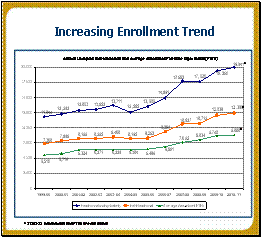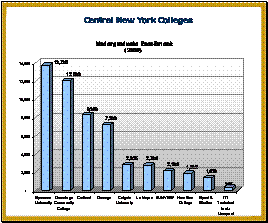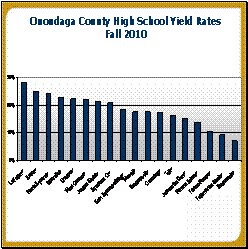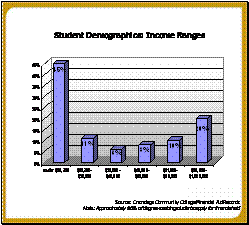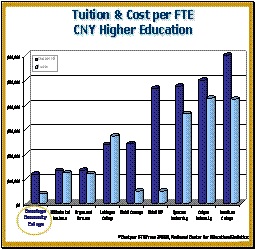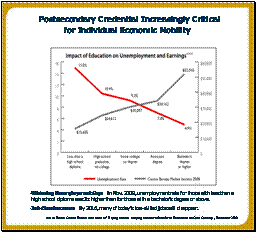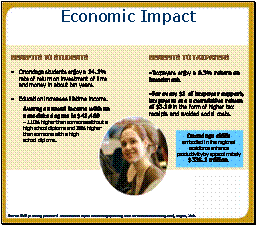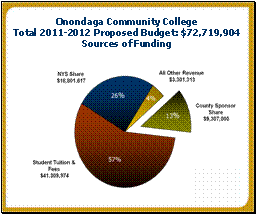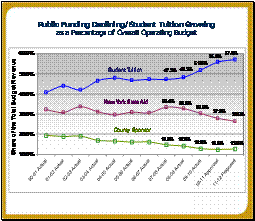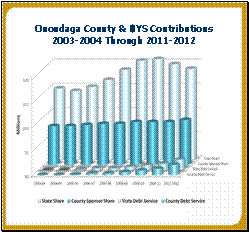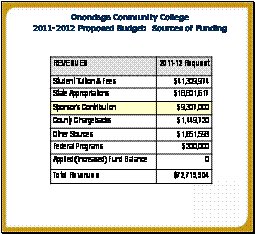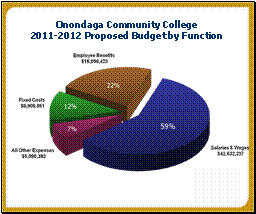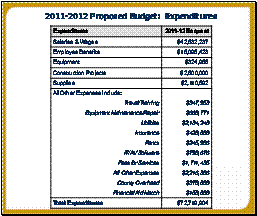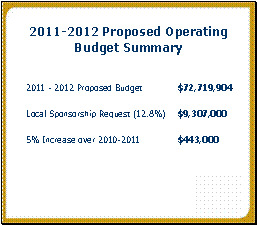ENVIRONMENTAL PROTECTION COMMITTEE MINUTES – JUNE 15, 2011
CHAIRMAN JAMES CORBETT
MEMBERS PRESENT: Mrs. Rapp, Mrs. Ervin, Mrs. Tassone, Mr. Buckel
ALSO PRESENT: Mr. Jordan, Mr. Rhinehart and see attached list
Chairman Corbett called the meeting to order at 10:02 a.m. Motions were made by Mrs. Rapp, seconded by Mrs. Ervin to waive the reading and approve the minutes of proceedings from the previous committee meeting. MOTIONS CARRIED.
Chairman Corbett stated he would be taking the agenda a little out of order. He has agreed to add item number 2 to the agenda. Realizing that there will be some discussion, this item will be taken first.
2. OFFICE OF ENVIRONMENT: David Coburn, Director
a. Amending the 2011 County Budget to Provide Additional Funds for Purchasing Compressed Natural Gas (CNG) Vehicles and Fueling Stations, and to Accept Clean Cities Grant Funds in Support of this Initiative
-
Step toward reducing our carbon footprint
-
Compressed natural gas (CNG) vehicles feature greenhouse gas emissions and lower fuel cost
-
Request funding for 7 CNYG vehicles and 3 time filled fuel stations (slower than expensive rapid fuel systems)
-
Clean Cities Grant will cover 100% of the incremental cost (additional cost over and above traditional vehicle replacement) of alternative fuel vehicles
-
Grant will cover 50% of the cost for time fueling stations; paid on a reimbursement basis
-
Advantages of CNG, price (currently $1.79 per gallon), 20% – 30% more fuel efficient , 25% less greenhouse gas emissions
-
Stimulus funds grant must be expended by the end of September 2011
-
Total County Cost $182,500
Mr. Corbett stated that these items did not make the cut during the vehicle review process. He understands that we will be getting the vehicles at a reduced rate but this is still costing $182, 500.
In answer to Mr. Corbett, Mr. Coburn confirmed that the fueling stations would be located at WEP, DOT and Parks. There are opportunities to use fueling facilities with Centro, National Grid or NYS; however the price is almost double. Current rate is $1.79 per gallon versus $.89 per gallon at your own facility. There is a clear advantage to having our own fueling stations.
Mr. Corbett questioned how long it would take for the capital outlay to pay for itself. Mr. Petrela stated that these vehicles were going to be replaced either way. Instead of replacing them with standard vehicles, we will be replacing them with CNG vehicles. Based on fuel savings they will be 1/3 cheaper to operate.
Mr. Corbett questioned if the mechanics have been trained on the up keep of this type of vehicle. Mr. Petrela stated that the fleet managers did not object or express any concerns about not being able to fix the vehicles. Mr. Coburn added that the vehicle is basically the same other than the fuel tank. Mr. Corbett stated that the intake around the motor and carburetor has to be different.
In answer to Mrs. Tassone, Mr. Coburn stated fuel price savings and convenience were the two major reasons for having 3 fueling stations. Other options are still available, however they would have to drive to the locations for filling and pay a higher price per gallon. He added that these are time fill stations. It takes 7 to 8 hours to fill a vehicle. Rapid fill stations cost between $750,000 and $1,000,000 and are usually created with grant money. National Grid has one rapid fill station north, there is a station located near the airport and Centro has one. National Grid is talking about building one somewhere near the City. Rapid fill stations fuel just as fast as a regular gas station. Fueling at $1.79, is still cheaper than gas at $3.72.
Mr. Buckel stated that this is very consistent with the policy passed by the legislature three years ago. He commends them for this. So often something innovative will be done by the executive side and it gets picked to death by the legislature. He wants to encourage the executive branch to continue innovative methods, however he needs data. He feels that the 3 stations indicate infrastructure planning to do fueling on a wide scale basis. Seeing the data could help to eliminate some of the nit-picking legislators do, and help us support this type of innovation.
Mr. Buckel requested a cost benefit analysis and short term/long term projections before the next session. Mr. Petrela stated this is simply comparing the cost of doing this verses not doing this. The cost of not doing this would be to replace the vehicles with standard vehicles. If you do this, you will pay 2/3rd’s of the cost. We are not adding vehicles; we are replacing vehicles that will go to auction. Instead of replacing the vehicles with standard vehicles we will replace them with CNG vehicles which cost less to operate. It is a given that there is a net positive internal rate of return. He has completed a quick evaluation for sedans. He has not looked at the pickup truck or SUV which result in greater savings. The person whom is the expert with this has told him that if he uses 2/3rd’s he is safe. The savings will be even greater for the larger vehicles.
Mr. Buckel stated that it really helps to have a simple spreadsheet with projected fuel costs and data, rather than relying on an expert. You can actually see the projected cost of operating both types of vehicles and show what you intend to do for future transformation of the fleet. A financial snapshot will assist in getting projects through the legislature. Mr. Petrela stated that this could be quantified. In his mind there is no question that there is a benefit here. At this time he cannot say what the actual dollar amount is.
Mr. Buckel stated that there are a lot of benefits in both tangible and untangible ways. If we are going to convert our fleet in the future, perhaps you should play this out over 5 years. List what will be coming off line and going to auction, and what the cost will be so that we have a broader prospective. Mr. Corbett added that in Mr. Petrela’ s mind this is already a good thing, however legislators need to be convinced of this as well.
Mr. Coburn asked that they keep in mind that the County Executive is coming out with a defined action plan later in the year. This will include a fleet component that looks more broadly at the fleet. Not just CNG or alternative fuel, but right sizing the fleet, right use, right travel planning, behavior change, idling policy and a whole host of things all collectively combined to make our fleet greener. You will be seeing a more comprehensive assessment of fleet changes in that package. We are ahead of the game here because of the grant time schedule. Mr. Buckel stated that he understands this, but the fact that we are building our own fueling stations tells him that we are trying to set the seeds for a long term conversion.
Mr. Corburn passed around a flyer pertaining to time fueled fueling stations for the committee’s review. He added that time fueling station are very small, just a few square feet. It is not a major capital project to put time fill stations in.
Mr. Corbett stated that during vehicle review he has always stated that besides taking care of the vehicle and washing the salt off, idling time is a big expense factor. It is a waste of expensive fuel and increases the carbon footprint for no reason.
Mr. Corbett stated that some sort of fueling schedule would be necessary to fuel 7 vehicles with 3 stations at a fill rate of 7 to 8 hours.
Ms. Rapp questioned if only one vehicle could be fueled at a time, per station. Mr. Coburn responded that he thought it was one but has heard that there is a possibility of two. Mr. Corbett questioned if the rate of fill would be the same with 2 filling at once. Mr. Coburn stated he would get back to the committee with the number of vehicles that may be fueled at once and the rate of fill, if filling more than one at a time is possible.
Mr. Coburn added that the vehicles would not be sitting idle for lack of fuel. It is a relatively short distance to the other facilities available to us. We will take advantage of our own fueling stations as much as possible to get the lower fuel cost.
In response to Mrs. Rapp, Mr. Coburn stated these vehicles were in the budget. Mrs. Rapp questioned why they were removed from the budget. Mr. Millea stated that if he recalls correctly all new vehicles were removed from the Budget Ways and Means report; it was not just these vehicles.
In response to Mrs. Rapp, Mr. Petrela stated the local dollars are broken down on the resolution. They are coming from the general fund balance for Facilities and Parks, WEP fund balance and DOT fund balance.
In response to Mr. Rhinehart, Mr. Coburn stated the vehicles could be left unattended and fueled overnight. Mr. Rhinehart questioned if there would be security around these stations. Mr. Petrela responded that the person, whom is the expert on this, stated that he has a fueling station like this in his garage. He plugs the hose in at night and it stops automatically. In the morning you simply remove the hose.
In answer to Mr. Rhinehart, Mr. Coburn stated that they would have to determine exactly where the fill stations will be located. Public and commercial use requirements are different for safety reasons. These may not be indoor facilities. Mr. Rhinehart suggested that they may want to know exactly where the fill stations will be located before going ahead with this. Mr. Coburn responded that the vehicles will be locked. Mr. Rhinehart stated he understands that but there will be hose hooked up to the vehicle with natural gas coming through it. Mr. Coburn added that the hose will shut off automatically.
In answer to Mr. Rhinehart, Mr. Coburn stated that these vehicles can be repaired locally. Their understanding is that these vehicles require less maintenance over all. Overtime he would like our maintenance people to be trained in this area. The training is not very significant; it is mostly safety related.
In answer to Mr. Rhinehart, Mr. Coburn stated that the City and Rochester have CNG vehicles. CENTRO also has them and National Grid is moving aggressively toward this. They all are very happy with the change. Their maintenance people have had no challenges.
Mr. Corbett questioned if the vehicles they were replacing have already gone to auction. Mr. Coburn stated that one has and the others will be. They are all vintage vehicles between 9 and 12 years old with 100,000 miles or more.
A motion was made by Mr. Buckel, seconded by Mrs. Rapp to approve this item. AYES: 3 (Rapp, Buckel, Ervin); NOES: 0; ABSTENTIONS: 2 (Corbett, Tassone). MOTION CARRIED.
1. LAKE IMPROVEMENT: Mike Lannon, Acting Commissioner; Matt Millea, Deputy County Executive Physical Services
a. ACJ Update (On file with the Clerk)
Mr. Lannon stated that before going into the update he would like to review the new format. At the last meeting we discussed incorporating budget sheets. Pages A-3 to A-5 list budgets in the new format; total proposed budget, expended to date, and authorization remaining. We believe this is a straight forward, user friendly approach. We will be working over the next couple months to continue improving the report format. We are talking about not including some of the backup information or revising it into another format. There is a lot of information to digest.
Mr. Millea distributed fact sheet examples for the Save the Rain project. (Fact sheets inserted as discussed, further down in the minutes)
He stated that these sheets will be posted on the website for both green and grey projects. They hope to incorporate some of the more contemporary fact sheet information for green projects in this report and highlight what is included in text. He will touch on these in more detail further on in the agenda. They are continuing the enhancement of these reports and will be working with the committee over the next several months.
Mr. Lannon asked if anyone had any question regarding the format. Mr. Corbett stated he would need some time to review the reports as this is the first time he has seen the new format.
Green Program Highlights
- Oncenter green roof construction on schedule; 90 day construction window, another 60 days for completion
- Tree planting contract has been awarded, installing 600 trees for 2011; total of 8,500 trees by 2018
- Oncenter parking garage to be advertised soon
- Erie Canal Museum and Hazard Branch Library bids are being evaluated
- War Memorial project has been bid, awaiting the return of the bids over the next few weeks
Mr. Corbett questioned if they were currently doing any preliminary work on the roof. Mr. Millea stated that there was an incident last week and facilities responded right away. We are not sure that it had anything to do with the work on the roof. Mr. Corbett stated that he wanted to be sure that there were not contractors currently working on the roof for the water reuse project. Mr. Millea responded that contractors are on the roof. They have been working with the US Bowling Conference and the Oncenter to assure that they are not inconvenienced. We feel that appropriate steps were taken in advance. We received notification that someone found something in their drink that they believed came from the ceiling. Facilities immediately addressed the concerns with the contractor.
Mr. Corbett stated there was a concern that this affected the alleys as well. Mrs. Rapp stated that the bowlers are stating it is very noisy. Mr. Millea asked the committee to notify them if they hear anything further; adding that Mr. Lynch is very vigilant.
- Townsend Street parking lot and median have been completed, very pleased with the out come
- Final details are being completed for Concord Place
- Version 2 of the County’s Green Improvement Fund is on the web, focused toward storm water capture
- Continue to expand the use of the website, project plans, fact sheets, as much information as possible
Progress for Projects Under Construction
- Harbor Brook Interceptor Replacement Project in the final stages, 85% complete
- Sheet piling installation continues for soil stabilization at the Midland CSO Abatement
Projects in Design Stage
Ambient Monitoring Program
- Working with the state for a revised AMP program; enhancements to further gauge the effectiveness of the green and grey program
Contracts
- 3 new contracts for reimbursement of green improvements in the Clinton Sewer Shed with St. Lucy’s Church, Tash Taskale and Putnam Properties
- Continue to have great interest from the public with regards to green infrastructure
Funding (Appendix A1-A2)
- Pages A1 – A2 are status quo, pages A3 – A5 speak to the revised summary report
In answer to Mr. Corbett, Mr. Lannon stated that several of the sheets were driven through the 48” sewer pipe which caused problems upstream with basement flooding. The contractor has been very proactive reaching out to the affected citizens. They took immediate measures to clean up the 6 or 7 affected basements. There is currently one person still living in a hotel while they continue with the clean up.
Mr. Corbett stated that he was questioning how they were not aware of the 48” main pipe. The site should not be dug without markings. Mr. Lannon stated that they expect to receive a report from CDM and C&S on Monday. Mr. Millea stated that they understand that the site was marked. Mr. Corbett stated that when it is appropriate he would like to be updated and informed of the report and any legal proceedings.
Mr. Corbett asked if our conveyances or Honeywell’s were being put in adjacent to State Fair Blvd. Mr. Lannon stated that he believes it is Honeywell. They are starting to install the dredging pipeline from the lake to the wastebed. They will also be installing a return line that will eventually come to Metro.
Mr. Corbett and Mr. Millea will meet to discuss the committees input on the website changes, green improvement fund, and fact sheet changes.
Mr. Millea stated that the fact sheets provided are samples of what will be incorporated into the report going forward. Rather than having different information, it will be the same as the website. They are trying to highlight the important information in the box on the upper right side. If you feel that that something is missing, please let them know and they will be happy to make any changes. They are trying to work together for a standard approach that will be universally understandable and available on the web as well as at the committee meetings.
In answer to Mrs. Rapp, Mr. Millea stated that the fact sheets will be updated as the project progresses.
In response to Mr. Millea’s request for comments, Mr. Rhinehart stated that more than a brief flyer is necessary to approve the CNG vehicle purchase and filling stations. Detailed information is needed. Also, the Save the Rain bill board located on 690 W. (near Midler Ave.) is very difficult to read. It is light blue and white, perhaps different colors would be better. Mr. Corbett stated that he has been by there a couple times and has not even noticed it. Mr. Millea stated that they would take a look at it; this may not be an ideal location.
3. WEP: Mike Lannon, Acting Commissioner; Matt Millea, Deputy County Executive/Physical Services
a. Authorizing and Ratifying the County of Onondaga to Act as Lead Agency for the War Memorial Arena at OnCenter Rainwater Reuse System Project, the Harbor Brook CSO 018 Constructed Wetlands Pilot Treatment System Project, and the Syracuse City Hall Forecourt Plaza Landscape Enhancements Project (The “Projects”) Under the State Environmental Quality Review Act (SEQRA) and the State Environmental Review Process (SERP); Determining the Classification of a Type I Action; Adopting a Negative Declaration; and Authorizing the Publication, Circulation, Service and Filing of the Environmental Assessment Form, and the Negative Declaration
- Project fact sheets were reviewed
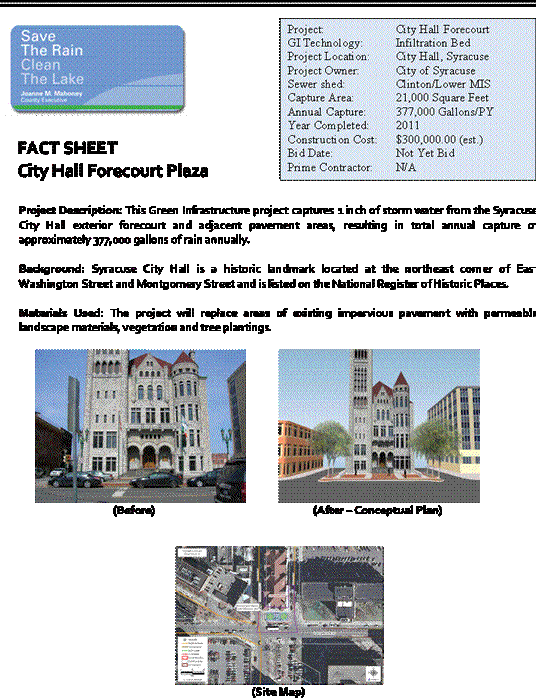
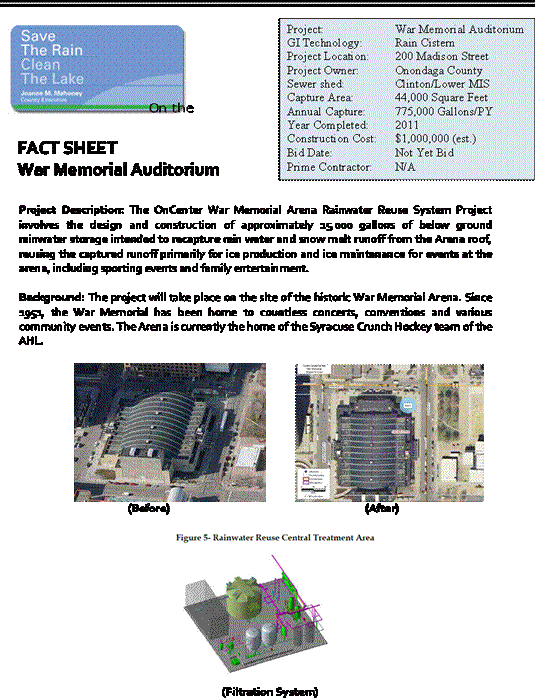
- UV system and chlorine tablets will treat the water so that it may be stored for a period of time
- Green tank is for storage
Mr. Buckel questioned if they would be using 775,000 gallons of water just for the ice. Mr. Lannon stated that he could not speak to this directly. He knows that the zamboni sprays water to clean and resurface the ice. There is also scheduled maintenance to melt the ice and create a new surface. Mr. Millea added that they hope to use some of the water for irrigation and potential heating/cooling of the Oncenter. They will make a full engineering report available on the project.
In answer to Mrs. Ervin, Mr. Lannon stated that there would not be damage to the roof. Mrs. Ervin stated that the Veteran’s were concerned. Mr. Lannon added that the plan is to preserve the outside of the building as much as possible, particularly because of the historic aspects of the building.
Mr. Rhinehart stated that the second whereas clause from the bottom of the first page of the resolution states that “copies of these documents, maps of the Projects, have been submitted to this Legislature and are on file with the Clerk of this Legislature”. These documents are not on file. Mr. Millea stated that he is unsure about the maps. The fact sheets provided detail information. Mr. Rhinehart asked where the SEQRA information was. Mr. Lannon stated that he believes some of the information was presented as part of the presentation done by Matt Marko a while back; as far as the War Memorial Project is concerned.
Mr. Rhinehart stated that he would like to see more information on the City Hall project. The resolution states these items are on file, we did not write the resolution. Mr. Millea stated that he understood and would get the engineers report for City Hall. He believes the City Hall Green Project was included with the budgets universal list. This is just advancing on the project. As far as the maps go, he is not sure why the resolution is worded this way. Mr. Rhinehart pointed out that the resolutions was drafted by them, not the legislature.
Mr. Corbett stated that he apologizes; he believes that this wording may have been told to him. He did not follow up to be sure the copies were on file. For the resolution to advance, the copies need to be filed with the Clerk.
In response to Mr. Millea, Mr. Mendez stated WEP should have something on file. It could be a map or a blueprint and the environmental findings.
Mr. Rhinehart stated that resolutions continue to come to this legislature without the backup information. This resolution is basically incomplete. The committee Chair or on occasion the name of another legislator is listed on the top of the resolution; we should have this information. Mr. Millea responded that he understood.
Mr. Corbett stated that the SEQRA is required as part of the resolution. He is not sure that this would be a legal proceeding if they advanced the item without these documents.
Mr. Buckel stated that he believes it is important to act on data information.
Chairman Corbett stated the item would be tabled until the backup information has been placed on file with the Clerk. Mr. Millea stated he agrees and appreciates the committee’s patience in waiting for the information.
Mrs. Rapp asked that they review the remaining fact sheets provided.
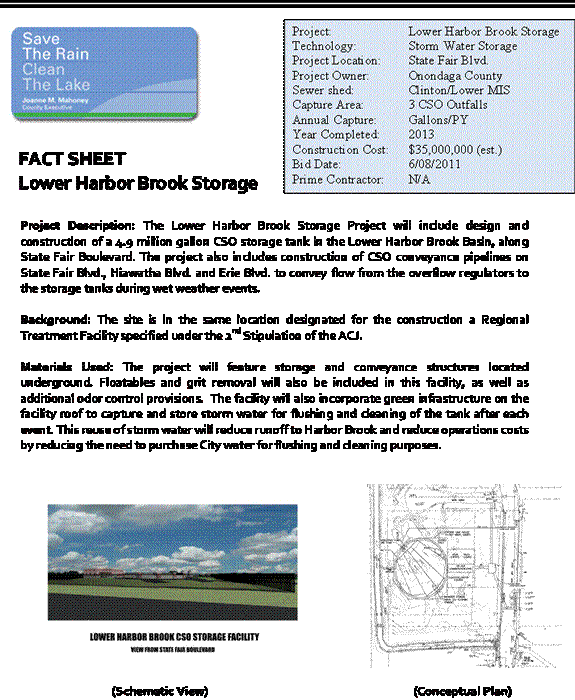
- Coincides with the conveyance project CSO03 and CSO04; eventually CSO63 will tie in as well
- Facility will have odor control (photos on file with the Clerk from last committee meeting)
- Meeting with neighbors will take place in the next few weeks for their input
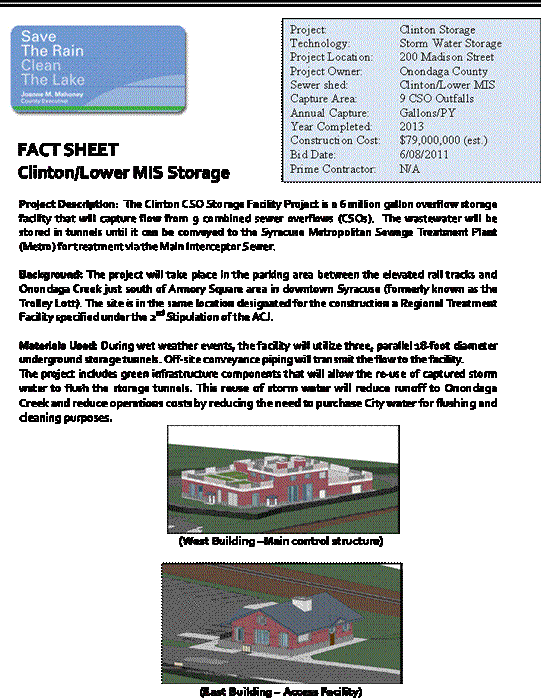
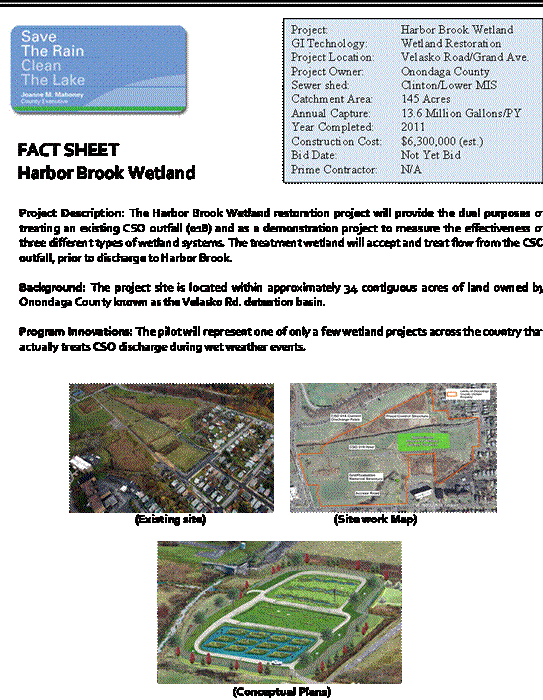
- Located near the intersection of Velasko Road and Grand Avenue
- Upstream from this wetland will be a grid removal structure, want to capture this material
- Construction anticipated to begin this fall
b. Amending the 2011 County Budget to Accept Grant Funds from the United States Department of Agriculture, Forest Service, Urban and Community Forestry Program for the Urban Forests for Stormwater Management Project ($80,680)
- Develop a comprehensive plan for CSO control and urban forestry restoration and management
- Focusing on vacant lots in the sewer sheds of Clinton, Midland, Harbor Brook and Erie Blvd.
- Reimbursement based grant, no matching funds needed
- No cost to the County
A motion was made by Mrs. Rapp, seconded by Mrs. Tassone to approve this item.
- All trees planted as part of the Save the Rain program will be entered into the Maximo System
- City of Syracuse is doing a city wide tree inventory
- Maximo is controlled by WEP; system is owned by the County
- Maximo will drive the care and maintenance schedule of the trees
- Labor will be part of the Green Jobs program
- Trees are part of the ACJ 250,000 capture; approximately 3%
- Working with the City/County arborist for proper placement and tree type for best capture
- Maximo will assist in monitoring the capture rate
Mr. Corbett stated it was a good thing that they were consulting with the arborist. There were a number of trees planted in the past that had to be cut because they got to tall for the power lines or the fumes killed them.
The committee agreed to a future presentation by the City/County arborist based on Mr. Millea’s offer to set up the meeting.
Passed unanimously. MOTION CARRIED.
c. A Resolution Calling for a Public Hearing in Connection with Acceptance by the Onondaga County Sanitary District of the Seventh North Street Water Main from the City Of Syracuse
Arial photograph was reviewed by the committee. (On file with the Clerk)
-
Transfer ownership of 16” water main pipe for $1.00; approximately 9,625 feet
-
Need driven by overflow issues with the upper Electronics Park trunk sewer, several homes and manholes backed up
-
State took action against the County and issued a consent order mandating improve to the situation
-
O’Brien and Gear hired for evaluation of the system and alternatives for addressing the problem
-
Plan was developed with the State, to be completed in 2 phases
-
Phase 1
-
89 manholes rehabs throughout the length of the Electronics Park trunk sewer (yellow line on map)
-
Remove overflow relief of the upper Electronics Park trunk sewer into Bloody Brook
-
Install direct pipeline to the Liverpool storage tank
-
Final design to the State in late September, they will have 60 days to review
-
Phase 2
-
A portion of the flow from the upper Electronics Park trunk region will be sent through the abandoned City water main 16” pipe (black line on map), slip lined with a 12” HDP pipe
-
More direct flow to the Ley Creek pumping station
Mr. Corbett questioned the size of the yellow line conveyance listed on the map. When you have a storm and there is a big influx of water it can be a problem going from one size pipe to another. He would caution them; it might be advisable to use the same size pipe instead of have a 12” and 16”. Mr. Lannon stated he failed to mention that this will be a pump station. At the moment the flow is by gravity, however we will install whatever pumps are necessary to drive enough flow. There will be a junction chamber installed that will act as a wet well. Mr. Corbett stated this answered his question.
- Full time dry weather station operation, some cushion for wet weather as well
- Concerned stagnant water would develop in pipes if used only for storms
- An evaluation will be completed of the water pipe; digging for physical access points, camera will also be used
- Have some maintenance records from the City, was active until 2007
- Water line will provide substantial savings over another engineered solution
- Anticipate using a camera through the water pipe in the fall
Mr. Corbett stated this resolution is just for a public hearing. Mr. Millea added that they will provide a more detailed presentation when they come back to the legislature to request funding for the project.
A motion was made by Chairman Corbett, seconded by Mrs. Erwin to approve this item. Passed unanimously. MOTION CARRIED.
d. Amending the 2011 County Budget to Expand Onondaga County’s “Save the Rain,” Green Infrastructure Program ($200,000)
- Resolution was crafted in response to discussions from a previous committee meeting
- Original resolution proposed by the County Executive was reworked; tracks the wishes of committee members
- Expanding the Save the Rain footprint beyond the City of Syracuse
- Broader program, not just ACJ compliance
- Discussion with Central NY Regional Planning Board, prime the pump for green infrastructure projects in suburban communities
- Creates the authorization to go forth to our partners in local government for $3 million in local projects
- Projects to be vetted through WEP sewer use ordinance
- Assist in reducing the flow of storm water into the sewage system
- Bronson Road is one area that is being targeted for green infrastructure applications
- Funding in this resolution is for education and outreach presentations to local planning and town boards
- Future request will be for actually project authorization
Mr. Corbett stated that the last whereas clause contains terminology that a few legislators have spoken out about, “used for the expansion of the Save the Rain education and outreach campaign to all communities within the Onondaga County Sanitary District”. He is happy to see this wording added. This was a major stumbling block for some of the legislators.
Mrs. Rapp stated that the Regional Planning Board has been very successful in their storm water education. They have been meeting with town and planning boards. She asked if they would be carrying this message with us. Mr. Millea replied that they currently have a contract with the Environmental Finance Center at Syracuse University. They are providing education outreach within the ACJ footprint. Depending on our success with this we could work with them to expand their role into the suburban communities or we could work with CNY. We had discussion last week with the Department of Environmental Conservation. There is environmental project money that the County put into an account some time ago. It started as a $250,000 deposit and has now grown to about $325,000. He believes that DEC is considering taking $75,000 of that money and giving it to the CNY Regional Planning Board for the education outreach program. Mrs. Rapp added that since they are already out there they have developed relationships. Mr. Millea stated that these monies are not specifically targeted. The resolution is just saying is that they need funds for education and outreach. He could work with the committee on the best way to allocate these resources.
Mr. Buckel asked if there would be published capture rate criteria. Mr. Millea responded that this is where technical guidance will be important. There has to be a connection to mitigation of inflowing infiltration into the sanitary sewer. They can’t do a pure storm water project. This is why Bronson Road is a strong candidate. He believes there are already 6 or 7 projects that would meet the criteria. Mr. Buckel stated that there has to be a balance here. The legislature was concerned that just one part of our geography was benefiting. They want the entire region to benefit. The worst thing that could happen is that when you come back to us it becomes each legislator asking about their district. He hopes that they have very specific criteria, narrowing the request for compelling projects, wherever they may be located. Mr. Millea stated that first narrowing is the sewer use ordinance requirements and they will have technical guidance on top of that.
Mr. Corbett stated that we need to care of those issues costing us the most money. There are at least 6 projects that will be addressed down the road. Mr. Millea added that is why they are not putting funds into a project account for WEP to move forward with. Projects are not being chosen today. They will be coming back before the legislature with discussions on which projects to move forward.
Mr. Corbett stated that even though the criteria will be sewer and mitigation, some areas have such a huge infiltration that as a buy product, this will help with their credits for the MS4’s. In some places there will be a little aversion when they are told that they will have to spend money on their end to make the project happen. This is when you will know if they really want it.
A motion was made by Mrs. Rapp, seconded by Mrs. Tassone to approve this item. Passed unanimously. MOTION CARRIED.
4. Reporting - Hydrofracking Disposal Fluids (Mr. Millea)
Mr. Millea stated that he believes the memo from Mr. Lannon will address any concerns they may have.
Onondaga County
Department of Water Environment Protection
INTER-OFFICE MEMO

To: Mathew J. Millea, Deputy County Executive – Physical Services
From: Michael J. Lannon, P.E., Acting Commissioner of WEP
Date: June 8, 2011
Subject: Status Report: Onondaga County Legislature Environmental Protection Committee – Resolution 413, Dated May 3, 2011, Review Whether Any Additional Measures Could Be Implemented to Prevent Disposal of Hydrofracking Fluids and Flowback at Onondaga County Wastewater Treatment Facilities

In accordance with Resolution No. 413, dated May 3, 2011, the purpose of this memorandum is to provide a status report regarding the review of whether any additional measures could be implemented to prevent disposal of hydrofracking fluids and flowback at Onondaga County Wastewater Treatment Facilities (WWTFs).
Status of NYSDEC Regulations Governing Hydrofracking
New York State issued an executive order stating that no horizontal hydrofracking permits may be issued prior to the completion of a Final Supplemental Generic Environmental Impact Statement (SGEIS) on the Oil, Gas and Solution Mining Regulatory Program Well Permit Issuance for Horizontal Drilling and High-Volume Hydraulic Fracturing to Develop the Marcellus Shale and Other Low-Permeability Gas Reservoirs.
Background - On September 30, 2009, the NYSDEC released the Draft SGEIS for public review and comment. The comment period on the Draft SGEIS ended on December 31, 2009. Due to overwhelming number of public comments, an executive order was issued requiring the following.
-
The NYSDEC shall complete its review of the public comments, make such revisions to the Draft SGEIS that are necessary to analyze comprehensively the environmental impacts associated with high-volume hydraulic fracturing combined with horizontal drilling, ensure that such impacts are appropriately avoided or mitigated consistent with the State Environmental Quality Review Act (SEQRA), other provisions of the Environmental Conservation Law and other laws, and ensure that adequate regulatory measures are identified to protect public health and the environment.
- On or about June 1, 2011, the NYSDEC shall publish a Revised Draft SGEIS, accept public comment on the revisions for a period of not less than thirty days, and may schedule public hearings on such revisions to be conducted in the Marcellus shale region and New York City.
- Recognizing that, pursuant to SEQRA, no permits may be issued prior to the completion of a Final SGEIS, the Department, subsequent to the conclusion of the public comment period, shall report to the Governor on the status of the Final SGEIS and the regulatory conditions that are necessary to include in oil and gas well permits to protect public health and the environment.
As of the date of this memorandum, the NYSDEC has not issued the revised draft SGEIS; recent newspaper articles suggest the document will be released in July 2011. Due to uncertainties in the draft SGEIS release date and the public comments period, there is no indication when the Final SGEIS will be completed.
It should be noted that hydrofracking on vertical wells continues to be authorized by the NYSDEC provided the hydrofracking fluid volume is less than 80,000 gallons.
According to Virginia Wong, USEPA Region 2 Pretreatment Coordinator, all municipalities are required to have control mechanisms (permits) in place for hauled waste. Mrs. Wong is not aware of any municipalities in NYS currently accepting horizontal hydrofracking wastewater. USEPA does not prohibit the acceptance of hydrofracking wastewater, however, acceptance of the wastewater would be a Pretreatment Program modification and would require prior approval from USEPA. In addition, acceptance of hydrofracking wastewater requires adequate notification to NYSDEC, in order for NYSDEC to determine if a SPDES modification is necessary.
Current Control Methods for Monitoring Wastewater Acceptance at County WWTFs
The County’s primary control mechanism for controlling hauled waste and preventing the disposal of hydrofracking wastewater at County owned treatment facilities is the Waste Hauler Control (WHC) Program.
Currently, Onondaga County Department of Water Environment Protection (OCDWEP) accepts hauled wastes at one approved site – the Syracuse Metropolitan Treatment Plant. Hauled wastes are accepted from commercial waste haulers who possess an OCDWEP Waste Hauler permit in accordance with OCDWEP’s Waste Hauler Control Program Policies and Procedures (attached) and the Onondaga County Rules and Regulations Relating to The Use of The Public Sewer System. Waste Hauler permits are issued for one year and list all permitted vehicles, waste types and conditions for discharging wastes at the Metro Treatment Plant. Failure to adhere to the Waste Hauler permit conditions and/or the WHC Program Policies and Procedures can result in permit revocation and fines and penalties.
In addition to the Waste Hauler Permit and the Program Policies and Procedures, other control mechanisms currently in place which would prevent the disposal of hydrofracking wastewater at County owned Treatment facilities include sampling each truck that delivers waste to the Metro Plant. Samples are visually inspected, pH verified and a minimum of one sample per day is sent to the laboratory for metals analysis. Wastewater technicians cannot accept waste that is not properly manifested, is not a permitted waste type, or does not comply with pH limitations. Additionally, invoices are reviewed and account names and locations are verified.
Additional Measures To Prevent Disposal of Hydrofracking Fluids and Flowback
New control mechanisms that were recently implemented include a letter sent to all Waste Haulers that haul waste to the Metro Plant stating the County’s policy of not accepting hydrofracking wastewater. The letter was sent with the permit renewal applications. Also, a sign was placed at the Waste Hauler Control office stating the prohibition of hydrofracking wastewater. Wastewater technicians have been instructed to observe and immediately report any unusual hauled wastes and to report immediately before acceptance.
Additional measures such as monitoring for Naturally Occurring Radioactive Materials, common in hydrofracking flowback fluids and production water, do not appear to be feasible or practical at this time considering the other preventive measures already in place. Further, the New York State regulations for radiological water quality standards only exist for Class A surface waters (Onondaga Lake is Class B and C).
In conclusion, for the short-term, the County appears to be adequately protected to prevent the acceptance of wastewater sources generated from the hydrofracking process (drilling fluids, flowback fluids, and production fluids). We would suggest that upon the NYSDEC’s release of the revised draft Supplemental Generic Environmental Impact Statement (SGEIS) on the Oil, Gas and Solution Mining Regulatory Program Well Permit Issuance for Horizontal Drilling and High-Volume Hydraulic Fracturing to Develop the Marcellus Shale and Other Low-Permeability Gas Reservoirs, and prior to release of the final document, that we reconvene to discuss further measures that may need to be taken in light of the pending document. Specifically, whether the County should provide written comments on the draft SGEIS stating that Onondaga County has a policy, endorsed by the County Legislature, not to accept any wastewater generated from either vertical or horizontal hydrofracking processes and County owned WWTFs.
If you should have any additional questions or comments regarding this issue, please do not hesitate to contact me.
- Revised NYSDEC Draft SGEIS past due; understand it should be out sometime in July 2011
- County has reached out to their contact at the EPA and DEC
- County would need EPA approval to accept hydrofracking fluids
- Modification of the Metro SPDES permit, very difficult challenge requires working with the EPA and DEC
- Confident that the mechanisms in place are satisfactory to protect us
- Will keep an eye on the any revised Draft SGEIS
Mr. Buckel asked if our permit requires the full disclosure of every element and chemical used. Mr. Lannon stated they would ask for MSDS sheets. If it is a new discharge, we ask for characterization of the waste stream as well. Various parameters would be sampled. We would take these results and gauge them against our sewer use ordinance. Mr. Buckel stated that it sounds like you are defining certain parameters but we still won’t have full disclosure. Mr. Lannon responded that some of the information is preparatory and this raises concerns for them as well. Mr. Corbett stated that is why it is not coming here. Mr. Millea added that this is why there has not been a permit issued in NYS. It is his understanding that NYS will not permit horizontal drilling without full disclosure of exactly what is in the fluids. WEP is not in the practice of doing this analysis. They are not in the business of accepting this fluid as a business model. He added that with the sensitive systems that we have, we need to know what is in the waste stream. They will know what is in a waste stream of anything brought in. They are not going to jeopardize the valuable technology at METRO by risking it.
Mr. Buckel asked that they assume that the state enacts the requirement of complete disclosure; we would still have the discretion to say not in our facility based on the permitting process. Mr. Corbett agreed. Mr. Buckel asked the Law department if we had the right as a County to not allow these fluids. Ms. Berger stated that she believed so but would have to look into it further.
Chairman Corbett stated that he spoke at a hydrofracking rally last week. There were some SU Law students in attendance questioning, if one state could stop another state from crossing their border, due to the Interstate Commerce Act. He responded that there is nothing that states we are trying to stop them from crossing the line, but where are they going to bring the product if there is no one here that will accept it. One of the students responded that they had never considered it this way.
Chairman Corbett stated that he is very thankful that we have been proactive. The legislature wanted heightened awareness at all of our plants, Metro in particular. He added that we have spent years cleaning up Onondaga Lake through the amended consent judgment and are finally seeing the light at the end of the tunnel. We do not want to be in violation of federal regulations by discharging something like this into the lake. This would be taking a step backwards. He is happy to see that we as a County acknowledge and recognizes this.
Mr. Buckel stated that this is his question to legal; if it is determined that the County can take this stuff, would we still be bared or have problems under the ACJ. Ms. Berger stated that she would need to research this further.
Mr. Millea stated that in the event that hyrdrofracking is allowed and disclosure is required in New York State our SPDES permit may not speak to certain materials that are used in this process. We would not be able to accept it. We would have to proactively seek an amendment to our SPDES permit. This is another barrier. Mr. Buckel stated that we also have to watch out for an adjacent County that decides to take actions that would affect our watershed and our ACJ compliance.
Mr. Corbett stated that Auburn is allowing vertical drilling and is discharging into water that eventually comes back to Onondaga County.
Mr. Millea added that they are very diligent in watching what is contained in the SPDES permits. This is where the state has an additional area of responsibility. He is almost certain that they are struggling with the DEC. If they issue this permit they also have to adapt their SPDES program to permit it or drill down so much that no publicly owned treatment plant could accept it. He believes that this is where PA is headed now. They are barring publicly owned treatment plants from accepting it all together. Mr. Corbett stated that this is one of the reasons that it is going everywhere except PA. They are the poster child for everything that everyone has been telling them would happen.
5. Memorializing County Support for the Eventual Transfer of a Parcel of Land Along Onondaga Lake to the Onondaga Nation in Recognition of Their Sacred Interest in Onondaga Lake and the Historically Significant Events that Occurred on its Shores (Sponsored by Mr. Corbett, Mrs. Ervin)
Chairman Corbett stated that this resolution has been brought forward before. It has been massaged and moved around. There are two changes on this resolution and another item has been brought up that he would like to go over.
-
There was some concern of being sued. The nation through their representative has agreed to the following wording listed in the 5th whereas clause; “delivery by the Onondaga Nation of a release of claim and convenant not to sue Onondaga County, its officers, agents and employees”.
- Questioned the right to memorialize New York State when the resolution should be coming from Onondaga County first. Listed in the second resolved clause, “that the County Executive is hereby requested to pursue resolution”
Since the creation of this revised resolution, Mrs. Tassone has drafted another resolution with a few changes. One of the changes may be agreeable to Chairman Corbett. Currently the only parcel of land we are talking about is Murphy’s Island. It could be 10 to 100 years before the remediation necessary takes place on Murphy Island. Mrs. Tassone’s resolution states, “parcel or other appropriate parcel”. Chairman Corbett stated that he had said that there were no other parcels of land that would be available touching the shores of Onondaga Lake. He has found out since then that there may be another opportunity for another parcel that will be remediated within the next five years. The parcel is located near the site where Harbor Brook enters the lake. Rather than holding this resolution to one piece of land, there may be an opportunity for it to state “or other appropriate parcel on Onondaga Lake”. He needs to go over this further. He will be working with Mrs. Tassone and looking into the feasibility before taking the resolution to session.
Chairman Corbett state that some questioned if County would have the ability to deal with another country or nation. Fourteen years ago he was involved when the Federal Government and New York State started releasing the remains of all different Native American artifacts and bones back to their original owner or tribes. He stated that the Onondaga Nation came to us and asked if they could have a parcel of land located behind the old Jamesville prison. At that time it was agreed that we would grant them the land for a $1 waive. It took almost six months of negotiating because the Nation felt that this was still part of their land and did not want to pay the dollar to get it back. Onondaga County did in fact deed this land to the Onondaga Nation. This provides precedent; we have dealt with another nation or country in the past.
Chairman Corbett stated that he was anointed to the ceremony, the burial grounds were dug, and they inturned the buck skins and remains. He brings this up just to show that we have done this in the past. He hopes that everyone can be on board with this.
Chairman Corbett will consider the change of another appropriate parcel on Onondaga Lake. He needs to research to see if the parcel will in fact be available a lot sooner. He added that you may have heard him use the term that the Onondaga Nation does things for 7 generations. Because of the CSX, the remediation and because Murphy’s Island is a park this may take 7 generations. If there is another acceptable parcel of land on the shores of Onondaga Lake it may assist in making everything happen a lot sooner.
A motion was made by Chairman Corbett, seconded by Mr. Buckel to approve this item contingent upon an amendment by Mrs. Tassone. AYES: 4; NOES: 0; ABSTENTIONS: 1 (Rapp). MOTION CARRIED.
The meeting was adjourned at 11:40 a.m.
Respectfully submitted,
Katherine M. French, Deputy Clerk
Onondaga County Legislature
* * *
COUNTY FACILITIES COMMITTEE MINUTES - JUNE 16, 2011
KATHLEEN RAPP, CHAIR
MEMBERS PRESENT: Mr. Masterpole, Mr. Lesniak, *Mr. Dougherty, Mrs. Tassone, Mr. Kinne, **Mr. Cox
ALSO PRESENT: See attached list
Chair Rapp called the meeting to order at 9:08 a.m. A motion was made by Mr. Masterpole, seconded by Mr. Dougherty to waive the reading and approve the minutes of the proceedings of the previous committee meeting; MOTION CARRIED.
1. COUNTY EXECUTIVE: Bill Fisher, Deputy County Executive
a. A Local Law Amending Local Law No. 11-1990, as Amended By Local Law No. 19-1991, Authorizing the Lease of County Property for Operation of the Erie Canal Museum
-
Referencing attachment no. 1: Lease Agreement – June 14, 1990 the Legislature authorized County Executive Pirro to enter into a lease and in April 1991, County Executive Pirro entered into the lease;
-
Mayor Young, the City of Syracuse, and the President of the Museum, were all included on the agreement
-
Agreement to renew ever 5 years; requirement to revisit the Legislature for each renewal – never happened
-
Long term lease does not exist; currently month to month lease
-
2 buildings and an addition – Erie Canal Museum on Water Street
-
Weighlock Building: only one; addition on building as result of original lease - City of Syracuse built for Visitors Center
-
City of Syracuse takes a grant from NYS for heritage area funding - $45,000/year to operate the Visitors Center
*Mr. Dougherty arrived at the meeting.
-
NYS gave Weighlock Building to the County (1960ish) – had to have someone operate the Museum or reverts to NYS
-
Facilities Management carries out work because it is County owned
-
Lamanna Building – adjacent to the Weighlock building; purchased in 1977 for $170,000; houses museum collection
-
Previously owned by Joe Lamanna – Lamanna Florist
-
Agreement – Museum pays $1 – no material compensation to County
-
Museum required to have a canal museum and visitors center in operation; must submit annual budget to County
-
Museum is an Authorized Agency - $45,000 – budget available
-
Lease calls for County to pay: all utilities in both buildings and addition, general repairs and maintenance, capital improvements and necessary major repairs
-
All work subject to Facilities Commissioner’s prior approval and appropriated funds
-
Attachment no. 1 – sheet showing the costs of the County’s part of lease
-
Weighlock Building – 12,367 sq. ft. plus addition of 5,858 sq. ft. and Lamanna building at 2,335 sq. ft.
-
2010 – Facilities spent $94,856 on the buildings – operation and maintenance costs shown on attachment
-
2010 numbers about average – some years as low as $73,000 and as high as $135,000 – out of Facilities budget
-
On top of operating costs, there are capital expenses – parking lot, HVAC, roof, etc. all on County
-
Windows – money in 2010 budget for $70,000 - $100,000 but have not gone forward with replacement as of yet
-
Project pushed out to future – Facilities not having enough money for all projects wanted
Mr. Lesniak requested the breakdown of the Service Repair/Maintenance Agreements totaling $36,104.27. Mr. Fisher stated he would retrieve the information from Brian Lynch at Facilities in time for Ways and Means. Mr. Dougherty requested information on who the County is paying. Mr. Fisher replied that he would get the information.
Mr. Fisher continued:
-
New lease – almost same as old but carved out City portion for addition as it is built
-
Sublease for City to take the $45,000 from NYS and use towards operating the Visitors Center – Museum is looking for $53,000 from City for higher cost of living but they are getting the same $45,000 they’ve been receiving
Chair Rapp replied to Mr. Masterpole that it is unsure if the State’s contribution has gone up based on the cost of living. The State has not passed on more than that amount.
Mr. Fisher continued:
-
New lease term will start the effective date which may be July through the year 2020 – will come back to Legislature in 2015 for approval of the next 5 years
-
Possibly terminating the lease on the Lamanna building
-
Looking to sell; not sure if legally can or want to; not sure of Facilities cost separate from rest of Museum; unsure of what it would sell for
-
$750 for appraisal – give options and if in interest of County will come back to Legislature for approval
-
Not the plan at this time but do not want to get into lease until 2020 and have no options
-
Collection is Erie Canal collection – other collections housed at OHA, Salt Museum, St. Marie Among the Iroquois
-
May make sense to consolidate collections – not sure if makes sense at this time
- Collection at Lamanna building is art work and documents of the Erie Canal
Chair Rapp stated Jim Walsh received a grant to buy the building and redo it. It is a state of the art, temperature controlled building right next to the museum. Resale of the building is suspect because there are no windows, no fire escape and the alarms sound if temperature is above or below where it should be. Consolidation into this building is a great idea because this type of building is expensive to build.
Mr. Fisher continued:
- Museum was just credited by the American Association of Museums, highest national recognition a museum receives
- May – public celebration of this – County Executive very supportive
- No talk of closing the museum; the Weighlock building is the only one left of its kind
- Museum not in strong financial position to pay over $1; paying more than $1 could jeopardize continued operation
Chair Rapp commented the staff for the museum is down to 4 people, and it is amazing what they can do with the $45,000. The rest of what is needed, they raise on their own. Mr. Fisher stated there is funding in place for an improvement to the Weighlock building; no County dollars. This totals $600,000 from grants and private donations that will make changes to the exhibits in the Weighlock building and to Visitors Center; including a gift shop to sell more merchandise. The museum is moving in a positive direction but there is not much room to negotiate different terms financially.
Mr. Kinne asked about the status of the windows. Mr. Fisher responded the windows will not be done this year. The plan from the County Executive last September at budget was to fund this. Facilities cut this out when the Legislature reduced the funding. Mr. Fisher is not sure if the County Executive will have this in the 2012 budget but he would not be surprised. Chair Rapp replied the utility bill may be a lot lower if there wasn’t snow blowing in the windows.
Mr. Kinne stated:
- Mr. Lynch came in during budget and discussed how bad the windows were
- The building cannot be in that shape owned by the County
- Hopes the County Executive puts it in the budget and the Legislature recognizes the importance of the windows
- The County has a mismash of things and there is no general plan
- Several years ago, St. Marie Among the Iroquois was built and then the County got rid of it; OHA is in need of help
- Consolidation is a great idea; currently it is disheartening that museums are not being treated equally
- County and County Taxpayers do lots of work for Erie Canal Museum; not level playing field; needs to be addressed
Mr. Fisher responded:
-
County Executive’s office agrees
-
Extensive talks with OHA, initial discussion with Erie Canal Museum, discussion with Bill Lansley, Parks Commissioner (responsible for Salt Museum and St. Marie) – bringing those together in a more strategic way
-
Where the discussions lead will probably be in the next couple months – encouraging all to talk to each other
-
Example: group brought up by the IDEAS Collaborative from York County, Pennsylvania – developed the York County Heritage Trust where the Historical Society and one of the historical museums merged 12 years ago and since then each museum joined until there was only 1 for all – this 1 receives public sector funding, private funding, one executive director and one board of directors; all museums tied together and integrated
-
Encouraging Erie Canal Museum, OHA and Parks Department to look at this model or an alternative
Mr. Lesniak asked if the insurances have been kept up to date. Mr. Fisher responded when the authorized agency contract was signed with the Erie Canal Museum in January, they were in effect. Mr. Fisher will make sure the insurances are still in effect now. Mr. Lesniak requested copies of the insurances to ensure it is done. Mr. Lesniak questioned the numbers associated with the insurances and when they were last adjusted. Mr. Fisher responded it was not changed from 20 years ago, and it will be updated. Mr. Fisher responded to Mr. Lesniak that if the OHA could house the collection from the Lamanna building without expense to the County, and the building could be sold, it may make good business sense. All options need to be explored at this time. Mr. Lesniak stated that he will be abstaining because he would like to see the contract numbers and insurance information.
Mr. Fisher:
-
Current lease did not have the Water Street Gym, but the Erie Canal Museum had the Water Street Gym
-
2006 – Legislature approved a loan to the Erie Canal Museum to purchase the Water Street Gym
-
County also agreed to be a local sponsor for a grant from the NYS DOT - $1.2 million
-
As sponsor the County had certain responsibilities – when the County loaned the museum $499,000 to buy the gym, the County had an obligation to obtain an appraisal of the property; the appraisal was not done
-
Water Street Gym was purchased by the museum using the County funds
-
$1.2 million went to the purchase and improvements
-
More significant costs - museum could not raise money for exhibits that were not covered
Mr. Masterpole asked where the other $700,000 went. Chair Rapp replied it was a reimbursement grant that was never actually given to the museum.
Mr. Fisher
-
The grant was returned
-
The $700,000 could not be used for exhibits, façade or an operating subsidy for a money losing museum
-
Several million dollars raised to put it into operation; late 2008 early 2009 the Museum Board came to the conclusion to halt the project and raise more money when conditions were more favorable
-
State was notified; wanted the money back; asked the County for $431,000 (80% share of the purchase the State paid for) because the appraisal was never done
-
State threatened to hold back transportation money so the County wrote a check
-
County took a note in mortgage from the Erie Canal Museum in the amount of $557,000; includes the purchase of the gym and money fronted by the County for the project
-
Gym was sold; all money remitted to County: $324,100; $240,000+ owed to the County
Chair Rapp:
-
Frank Dean, who was with the State Parks Department, was in town looking for an office for the Parks Department
-
Nothing available in inner harbor but he wanted an office in Syracuse because of its central location
-
Interim director of the museum suggested a building right down the street
-
He’s not impressed with the building but with renovation it could be work
-
Grant with extra money available so the grant is submitted and Mr. Dean carries it through; $1.7 million grant awarded
-
NYS Parks is going to locate there, carry the costs of the building and give the museum a place downstairs for a state of the art museum to bring in Smithsonian quality exhibits – money maker for museum; sounded great
-
2 years he was paid $3,000/year to keep operating costs while trying to get organized
-
Frank Dean then got a job in Washington and said it was not going to happen after all
Mr. Masterpole asked if there were appraisals done on the buildings that the County is leasing. Mr. Fisher replied there have been no appraisals on either building. The buildings being leased do not need to be appraised but it would be a good idea to appraise the Lamanna building to see if it would be worth selling. The County cannot sell the Erie Canal Museum; only stop operation and give back to the State. Mr. Masterpole stated he had a conversation with Mr. Murphy and was told the County cannot sell or lease a building for lease than the appraised value. Mrs. Tarolli responded for a private individual or business that is true, but there are provisions in County Law that allow for County funding to certain entities; one of which is to operate a museum.
A motion was made by Mr. Masterpole, seconded by Mr. Kinne to approve this item. Ayes: 2 (Masterpole, Kinne) Abstentions: 4 (Rapp, Dougherty, Lesniak, Tassone); MOTION CARRIED.
2. TRANSPORTATION: Mark Premo, Deputy Commissioner
a. Amending the 2011 County Budget and Authorizing the County to Pay in the First Instance 100% of the Federal and State Aid Eligible Costs at a Maximum Amount of $2,280,000 and Authorizing the County Executive to Enter Into Agreements for the Construction Phase of Costello Parkway (Minoa-Manlius Center Road, C.R. 55) Bridge Project, PIN 3755.56 ($2,280,000)
b. Amending the 2011 County Budget and Authorizing the County to Pay in the First Instance 100% of the Federal and State Aid Eligible Costs at a Maximum Amount of $2,755,000 And Authorizing the County Executive to Enter Into Agreements for the Construction Phase of Morgan Road C.R. 47 at Liverpool Bypass, C.R. 88, Paving Project, PIN 3754.16 ($2,755,000)
c. Amending the 2011 County Budget and Authorizing the County to Pay in the First Instance 100% of the Federal and State Aid Eligible Costs at a Maximum Amount of $2,850,000 and Authorizing the County Executive to Enter Into Agreements for the Construction Phase of Factory Avenue, C.R. 93 & LeMoyne Avenue, C.R.219 Intersection Safety Reconstruction Project, PIN 3753.88 ($2,850,000)
- Upfront costs for three construction projects as part of the County’s Capital Improvement Program
- County will front 100% then the Federal Government and State refund the County at 80% and 15% respectively
- 3 Projects: bridge on Costello Parkway, highway improvement at Morgan Road and Liverpool Bypass, and intersection improvement at Factory Ave and Lemoyne Ave
- $8 million total with an after cost to the County of about $400,000 – not based on interest costs
- Reimbursement turn around normally 1 – 2 years; stay on top; process getting better through Federal and State
A motion was made by Mr. Kinne, seconded by Mr. Lesniak to approve items 2a, 2b, and 2c.
-
Costello Parkway – rehabilitation to deck of bridge; deck replacement and rehab 1 or 2 of the piers; enter agreements with CSX to work in their right of way
-
Morgan Road – some widening; resurfacing project; new signal at Grampian Road for safety; adding righthand turn lane on Liverpool Bypass eastbound onto Morgan Road
-
Factory Avenue – safety improvement; replacing signal with updated equipment; new turn lanes
Passed unanimously; MOTION CARRIED.
Mr. Kinne asked who is in charge of the project on 298, from Taft Road to 31. Mr. Premo replied it is NYS DOT. The section of the roadway is in a swamp and tends to go through undue settlement. There was a bridge replaced there recently. It is nothing more than equalization; pathway from one side of the swamp to the other and right now taking into account reinforcement for when they repave.
3. OCC: David Murphy
a. A Local Law Authorizing the Lease of County Property to the Onondaga Community College Housing Development Corporation for the Construction and Operation of a Dormitory Facility for use by Onondaga Community College Students and Program Participants
- In 2005 OCC was successful in building three new facilities for student housing – currently holds 585 students
- Suite concept (full kitchen, common area, living room); demand for the product enormous; working on increasing beds
- Decided to take building on 173 –H3 building; used to be residence for nurses at Van Duyn
- Lays out like an old dormitory facility; redo to add 166 additional beds - 144 for single dorm rooms and the rest double
- 45,000 sq. ft.; three stories with a lower level
- County owns the property and trust for the College – then County gave the property to the College to utilize
- Financing – going through Onondaga Civic Development Corporation – tax exempt bonds to finance the project
- Citizens will buy 100% of bonds
- Open facility in August 2012
- Financing institution requires ground lease between Onondaga Housing Development Corporation, OCC and County
- Same lease as used back in 2005; no tax dollars used
- Total cost between $10 - $11 million – Onondaga Housing Development Corporation is paying back the loan from rent
- Price per square foot would approximately be 45,000 sq. ft. into 10 million – haven’t bid out ($220/sq. ft.)
- New construction is very expensive
Mr. Lesniak questioned whether it was less expensive to build a new facility instead of rehabbing the existing building. Mr. Murphy replied a good portion of the interior will be saved and there is no way to build this building at this cost.
Mr. Dougherty asked if there is an existing building of this size at OCC. Mr. Murphy responded there are three buildings with a total of 585 beds. This building will house 166 beds. Mr. Murphy replied to Mr. Dougherty that the expense of those buildings was approximately $19 million in construction costs, with soft costs adding a little more. The soft costs are included in the estimate for the H3 building; the construction costs are approximately $8.5 million. Mr. Dougherty asked about the lower level and if it will be a common area. Mr. Murphy responded there are windows so it will have rooms, laundry facilities and a common area with a workout facility. The other levels will also have a common area due to the horseshoe shape of the building. Mrs. Tarolli clarified for Mr. Dougherty due to educational law, the County has to give it to the College and Trust.
**Mr. Cox arrived at the meeting.
Mr. Murphy stated the building has been vacant for 12 years in response to Mr. Dougherty. Mrs. Curtin replied to Mrs. Tassone that the building is from the 1950’s. Mr. Murphy commented that the Department of Health was using the building for storage of records.
Mr. Masterpole inquired about the intersection at Velasko Road and Rt. 173 and how dangerous the turn is near where the housing will be. Mr. Murphy replied there is a stretch before the intersection to get to the housing.
A motion was made by Mr. Masterpole, seconded by Mr. Dougherty to approve this item.
Mr. Kinne questioned if the laundry room would be County run or private. Mr. Murphy responded typically there is a contractor who will bring in the equipment so there is no upfront cost. Mr. Kinne requested the information on OCC’s current laundry contract. Mr. Murphy will get the information. Mrs. Curtin explained the students use their student cards for the laundry machines, not coins. Mr. Kinne asked about the running track behind the property. Mr. Murphy stated there are paths that run down to Santaro Park; 60 acres. There are no plans to disturb any of the grounds around that. Currently OCC has successfully completed the H1 building which will open shortly, H3 will be student housing, and lastly the helicopter pad which is right near the tough corner. Mr. Murphy said he will get an answer on if there are any plans for the paths.
Mr. Masterpole asked about shuttles. Mr. Murphy replied there are sidewalks to H1 but are investigating the opportunity to have shuttles. OCC is trying to bring this into the heart of the campus in a food service standpoint and a transportation service to integrate it into the overall campus.
Mr. Murphy responded to Mr. Lesniak that this is all through the housing development. Mr. Lesniak asked about the cost of the new center per square foot? Chair Rapp responded that she believed it was bid out. Mr. Lesniak stated that a rehab can be more costly than a new building and Chair Rapp responded that the building is still the County’s property so it will be an issue now or later.
Ayes: 6 (Rapp, Masterpole, Dougherty, Tassone, Cox, Kinne) Abstentions: 1 (Lesniak); MOTION CARRIED.
The meeting was adjourned at 10:05 a.m.
Respectfully submitted,
Jamie M. McNamara, Assistant Clerk
Onondaga County Legislature
* * *
PLANNING AND ECONOMIC DEVELOPMENT COMMITTEE MINUTES - JUNE 16, 2011
KATHLEEN A. RAPP, CHAIR
MEMBERS PRESENT: Mr. Stanczyk, Mr. Dougherty, Ms. Williams, *Mr. Cox
ALSO PRESENT: See attached list
Chair Rapp called the meeting to order at 10:35 a.m. A motion was made by Ms. Williams, seconded by Mr. Stanczyk to waive the reading and approve the minutes of the proceedings of the previous committee meeting; MOTION CARRIED.
Chair Rapp took the agenda out of order.
2. COMMUNITY DEVELOPMENT: Robert DeMore, Administrator
a. Authorizing the Onondaga County Executive to File the 2011 Action Plan for the Community Development Block Grant, Home Grant and Emergency Shelter Grant Programs
- Authorization to file the action plan; required by HUD; covers 3 major grants – CDBG, Shelter Grant and Home Grant
- Down $600,000 from last year based on cuts – 2a backup has outline showing what the cuts are
- Capital Projects for the towns and villages – max $100,000 - 3 at $100,000 and rest are smaller; future will be smaller
- Buying a new house in Nedrow – looking to break even and only purchase those that will; in past have lost money
- Saving money because there is not a need for the Law Department with Mr. DeMore in office handling the lawyer side
- Budget for next year is what it is - down $600,000; internal budget about the same
Mr. Stanczyk noted it is nice to have a former Legislator in office because if Mr. DeMore sees something the County can do better in a different direction, different program or different attempt, the Legislature will listen intently. Mr. DeMore replied he is working on different projects, and he is looking to add another person to work on drawing down the money. The department can be slow at getting the money back in so they are looking to add one more person, and will come to the Legislature for approval.
Mr. DeMore continued:
- No local tax money being used; bring back one person; department will be about 1/3 position up from this year
- $4.7 million in 2010 – $4.1 in 2011 – will probably be less in 2012
- May have to downsize in 2013
- $3 million currently – application in for $2 million for Healthy Homes, new deal; only 7 nationwide
- Lead money is getting out right on schedule
A motion was made by Ms. Williams, seconded by Mr. Stanczyk to approve this item. Passed unanimously; MOTION CARRIED.
1. CONVENTION AND VISITORS BUREAU:
a. Report on Marketing Plan - David Holder
Mr. Holder:
- Making 3 promises: not asking for money, not talking about bowling and only talking return on investment once
*Mr. Cox arrived at the meeting.
 
 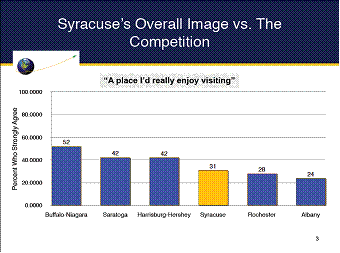
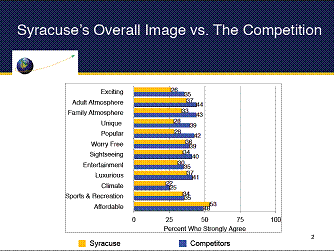 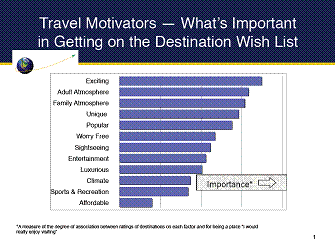
- The competitors in blue are their combined average numbers
 
 
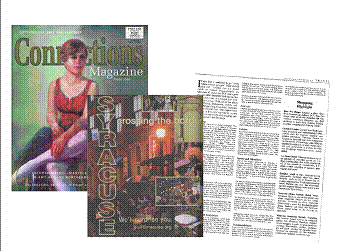 
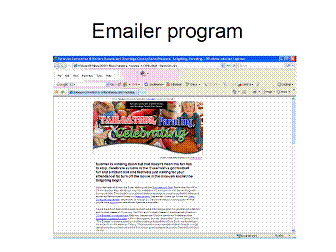 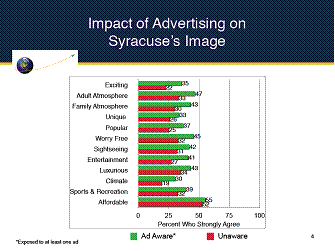
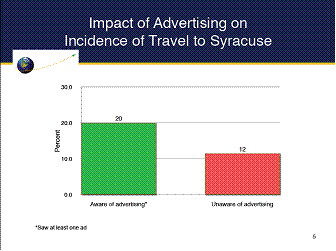 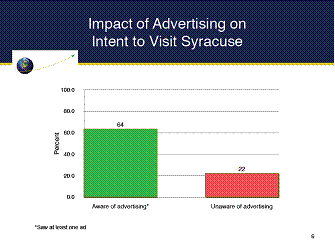
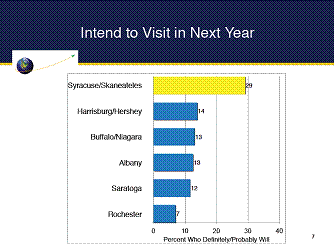
Mr. Holder:
- The above slide is the intention to travel vs. the slide in the beginning showing a place someone would enjoy visiting
- This was done in conjunction with the other questions on previous slides
- Work through a process to get to the questions – first questions are asked blind
- They ask the intention to visit question before showing recollection pieces
- Longwoods International performed the surveys
Mr. Stanczyk stated it is polling like the last congressional campaign. It is how you ask the question, and depends on when the survey was done. If it was performed right after an ad campaign for Syracuse, it may be fresh in their minds.
Mr. Holder continued:
- Survey was conducted in 3 market places – Wilkes Barre/Scranton, Albany and Ottawa
- Wanted to roll out the campaign and then measure what the campaign was able to generate
- Shifts seen in awareness; high intention to visit – need to keep hitting the messages to turn intention into an actual trip
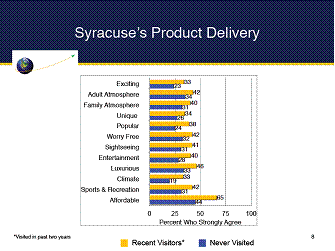 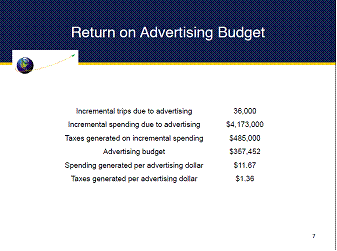
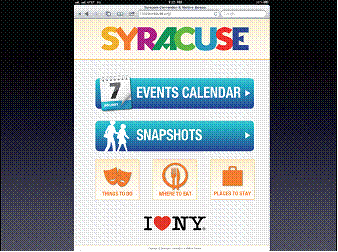 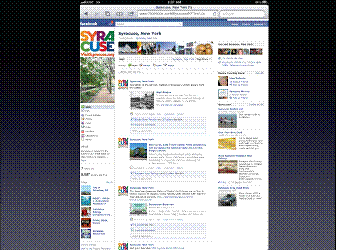

-
New in 2012: version 2.0 of an image program for Syracuse – designed to be heavier in PR, social networks, online advertising, and no T.V. commercials
- Looking at new target markets, and what they can do for the County
- Change messaging, and start really concentrating on a brand image – build with the knowledge of the Legislature
Mr. Stanczyk commented the measures of success will be how well the room occupancy tax is doing in terms of growing, and how well the Convention Center business is doing. It is important to keep moving forward. Mr. Holder replied they are targeting the marketing program in terms of drilling down to specific audience bases, and keeping the message the same throughout. In answer to Chair Rapp, Mr. Holder explained with the satellite office in Washington with Bill Adams, he is looking at the Washington D.C. area to expand marketing to. When Mr. Holder was in Corning, there was a limited reach into that market place, and it proved very fruitful. Looking at a destination side, there is a lot of messaging in the D.C. area. This can also help Mr. Adams in talking to people about bringing their events to Syracuse.
Mr. Stanczyk stated his wife had cousins coming in to town that had never been to Syracuse, and they were trying to find things to do. The Carrier Dome is always seen on T.V., and suggested doing a walk through the Dome; which is now arranged. Mr. Stanczyk went to Seattle to the ballpark, and if someone goes to Boston, they would want to see the ballpark. People see the Carrier Dome all the time, and if there is no event going on, at least the Dome could be available for tours. If the County had a better relationship with Syracuse University, the County could have some available seating for people to come in and buy tickets to the Dome. Buffalo has Niagara Falls, and Saratoga has the race track. There needs to be a nice draw like tours of the Carrier Dome to say come in and see what you’ve seen on T.V. There doesn’t seem to be a big asset to draw people in. Mr. Holder replied there are very strong connections with the University, and a tourist piece is set up on an individualized basis. Mr. Stanczyk commented that it shouldn’t be and Mr. Holder agreed. Mr. Stanczyk went on to say there should be allowances for tickets people can buy to enjoy a game close to the court not in the rafters. Mr. Holder responded there have been programs with Syracuse University with football tickets but basketball is a little harder. In answer to Mr. Dougherty, Mr. Holder said there are strong programs with the Chiefs and the Crunch. Mr. Stanczyk asked about the marathon at Onondaga Lake Park. Mr. Holder responded they are doing the room night piece for the event to help coordinate the relationships with the Sheriff’s Office and Public Safety. The half iron man is another great example of the connections with the community to start growing market places that are highly fruitful. Chair Rapp commented a triathlon center is in the process of being opened in Skaneateles.
The meeting was adjourned at 10:58 a.m.
Respectfully submitted,
Jamie M. McNamara, Assistant Clerk
Onondaga County Legislature
* * *
WAYS AND MEANS COMMITTEE MINUTES – JUNE 24, 2011
CASEY E. JORDAN, CHAIRMAN
MEMBERS PRESENT: Mr. Corbett, Mr. Lesniak, *Mr. Holmquist, Mr. Kilmartin, Mr. Warner, **Mr. Buckel, ***Mr. Kinne, Mr. Stanczyk
ALSO PRESENT: Mr. Meyer, see also attached list
Chairman Jordan called the meeting to order at 10:15 a.m. A motion was made by Mr. Corbett, seconded by Mr. Warner, to waive the reading and approve the minutes of the proceedings of the previous committee. MOTION CARRIED.
1. COMMUNITY DEVELOPMENT:
a. Authorizing the Onondaga County Executive to File the 2011 Action Plan for the Community Development Block Grant, Home Grant and Emergency Shelter Grant Programs
A motion was made by Mr. Stanczyk, seconded by Mr. Corbett to approve this item. Passed unanimously; MOTION CARRIED.
2. TRANSPORTATION: Brian Donnelly, Commissioner
a. Amending the 2011 County Budget and Authorizing the County to Pay in the First Instance 100% of the Federal and State Aid Eligible Costs at a Maximum Amount of $2,280,000 and Authorizing the County Executive to Enter Into Agreements for the Construction Phase of Costello Parkway (Minoa-Manlius Center Road, C.R. 55) Bridge Project, PIN 3755.56 ($2,280,000)
b. Amending the 2011 County Budget and Authorizing the County to Pay in the First Instance 100% of the Federal and State Aid Eligible Costs at a Maximum Amount of $2,755,000 And Authorizing the County Executive to Enter Into Agreements for the Construction Phase of Morgan Road C.R. 47 at Liverpool Bypass, C.R. 88, Paving Project, PIN 3754.16 ($2,755,000)
c. Amending the 2011 County Budget and Authorizing the County to Pay in the First Instance 100% of the Federal and State Aid Eligible Costs at a Maximum Amount of $2,850,000 and Authorizing the County Executive to Enter Into Agreements for the Construction Phase of Factory Avenue, C.R. 93 & LeMoyne Avenue, C.R. 219 Intersection Safety Reconstruction Project, PIN 3753.88 ($2,850,000)
Mr. Donnelly explained that these are 3 federal aid projects; the resolution authorizes the county to pay in the first instance and get reimbursed by the federal government.
A motion was made by Mr. Stanczyk, seconded by Mr. Lesniak to approve items 2a, 2b, and 2c. Passed unanimously; MOTION CARRIED.
3. PURCHASE: Sean Carroll, Director
a. Revenue Contract Report
One new revenue contract pending; put out for RFP to have public ability to send and receive faxes at the library. Results are expected before the July Ways & Means meeting. The public would pay an amount to send or receive a fax; County would get a percentage of the rate charged to the public. In the RFP vendors are required to suggest a price to charge the public. In answer to Mr. Lesniak, Mr. Carroll indicated the fax system will be compatible with the VOIP system. Some fax lines will have to remain as copper lines. The library will be on VOIP.
4. OFFICE OF ENVIRONMENT: David Coburn, Director
a. Amend 2011 Budget to Provide Additional Funds for Purchasing Compressed Natural Gas (CNG) Vehicles and Fueling Stations, and to Accept Clean Cities Grant Funds in Support of this Initiative
Mr. Coburn:
- Gas is in central New York is $3.76; a compressed natural gas vehicle would cost $1.79/gallon this week
- Greater fuel efficiency, but because it doesn’t burn as hot, there is a shorter range in terms of gas
Mr. Warner asked if the resolution mentions the extraction of natural gas, hyrdofracking. Mr. Coburn said “no”.
Chairman Jordan questioned what other options are available; why this is a better option; what the long-term costs are. Mr. Coburn said that the County’s Environmental Sustainability Committee created a sustainable fleet – looking at ways to make fleet activity more sustainable over all, i.e. using alternative fuels, etc.
-
CNG has advantages over others; not saying that CNG will be the answer to everything.
-
Viewed as a pilot project
-
A lot less expensive: $1.79 right now to fill up at another place, i.e. National Grid, Centro, NYS DOT, it could be as low as $.89 with County having its own fueling stations
-
Proposals includes 3 time-filled fueling stations, half of the cost is covered by CNY Clean Cities Grant
-
Order 7 vehicles – 2 sedans, 3 SUVs, 2 pickups – use will vary between them
-
Maintenance costs are less – 20% - 30% fuel efficiency
-
Better to try CNG now because if there is down time with the fueling station, there is are other local options
Cost Benefit Analysis (see attachment a) Ruston Petrela:
-
Looked at vehicles to be replaced and average miles per year that they have done - considered the cost per gallon and calculated the annual cost – did the same for CNG
-
Outside fueling is more expensive conservative estimate to go outside is to subtract one dollar from the regular price of fuel; if fueling in-house subtract $2 from cost of regular fuel.
-
Annual savings is $7,700; fuel station will cost $7,500 – savings will pay for them in 3 years
Mr. Stanczyk clarified that this is spending $309,000, replacing 7 vehicles; vehicles converted to burn compressed natural gas; questioned if they are more expensive than regular vehicles. Mr. Petrela said “no”, the cost of the conversion is being paid by the grant. Mr. Coburn said that the outfitted additional cost varies by vehicles – sedan is about $7,500; trucks & SUVs about $18,000. Mr. Stanczyk noted that the 7 vehicles to be replaced weren’t scheduled in the budget; Mr. Coburn said that they were requested in the 2011 budget. Mr. Stanczyk said that they weren’t accepted; there is a budget in place that doesn’t include these vehicles.
Mr. Coburn continued:
- Incremental additional cost is 100% covered by CNY grant, stimulus
- Stimulus money has to be expended by the end of September
- Cost of converting the 7 vehicles is $126,500
- Grant covers 50% of fueling stations - $15,000 installed each; County cost is $22,500
*Mr. Lesniak questioned where the money is coming from for the vehicles. Mr. Petrela explained that for WEP, it will come from sewer fund; for Facilities and Parks it will come from general fund; from DOT it will come from DOT fund balance. (*see clarification on page 3)
In answer to Mr. Lesniak, Mr. Coburn explained that the quick-fill stations cost approximately $750,000 to install – want to be sure there are long-term cost savings before installing them. One reason to go with CNG is for the redundancy. In most cases, we want to take advantage of more extreme cost savings by using our own gas. In the cases where they can’t, it is still a very substantial cost savings to go to quick fill facilities. For the convenience and cost savings, want to have the time filled stations. Two vehicles can be filled at once. Mr. Lesniak said that if more vehicles were added, the stations are done, as they can only fill two at once and it takes 8 hours to fill them. Mr. Coburn said that is why they want to get the experience now, to determine if more investment should be made in CNG. Mr. Lesniak suggested just using the filling stations at the other locations, rather than spending $22,500 or $45,000 of taxpayers’ dollars with going into something that we are not sure we may get into – could be throwing $45,000 away. Mr. Petrela said that the savings estimation is conservative; could save close to $10,000 per year. Mr. Lesniak said that there is a grant this time, but if they are to be replaced, it is $126,000 additional cost. Mr. Petrela said that they don’t have to be filled with CNG vehicles. Mr. Lesniak responded that there would then be filling stations that they shouldn’t have bothered to put in. Mr. Coburn said that even if the County didn’t get the fueling stations, there is still substantial savings in getting the CNG vehicles; the fueling stations are small and have resale value. The expectation is that the County will confirm everything that it is hearing from everybody who has already made this move – better economy, less maintenance, save money long term. The next move would be to get into the program in a bigger way. Mr. Lesniak said it would have to e a quick fill station.
Mr. Coburn said that there are 3 quick fill stations now – Centro, State DOT, and National Grid. National Grid is considering another one in the city. In answer to Mr. Stanczyk, Mr. Coburn said that the County would have the ability to use Centro’s station for $1.79/gallon.
Mr. Stanczyk asked about the cost to the taxpayers. Mr. Petrela said $80,500 is coming from general fund balance. The total cost is $182,000. Mr. Stanczyk said that if the departments are getting a benefit, they should find money within their budgets this year because the budget was already set for 2011.
Mr. Holmquist said that the Executive has been instructed not to use any more fund balance and questioned why proposals keep coming over using it.
In answer to Mr. Kinne, Mr. Coburn explained that the rapid fill stations allow filling CNG vehicles just as rapidly as a regular gas tank. Mr. Kinne question where the proposed 8-hr. fill station will be built. Mr. Coburn said WEP, Parks, DOT. Mr. Kinne said that if the cars are purchased, and don’t work out after 5 years, can they be converted back; what will the cost be. Mr. Coburn said that probably the cars would be sold back at that point; there is a market for them. In answer to Mr. Kinne, Mr. Coburn said that the County should know within 2 years whether or not there are any unanticipated elements to using CNG. He didn’t know if at that point, they would come to the legislature asking for a quick fill station. The objective would be to find as much outside financial assistance as they can. A cost benefit analysis would be done at that point. In answer to Mr. Kinne, Mr. Coburn said that he spoke to CENTRO and the cost for the County today would be $1.79 – City and private citizens can use Centro right now.
In answer to Mr. Stanczyk, Mr. Coburn explained that the City constructed a CNG facility, but it is down now in disrepair. They had converted some of their larger vehicles. Mr. Corbett said that they are using electric vehicles now. Mr. Stanczyk asked if the grant can be used to purchase electric vehicles. Mr. Coburn said that it could, but hybrids don’t have as much cost savings because they are still using gas. In answer to Mr. Lesniak, the city’s CNG fueling station has about $100k in repair, which they have not invested in. He did not know how old the facility is.
*Mr. Corbett asked for clarification of the funding. Mr. Seitz said $80,500 is from general fund balance; $43,500 from road machinery balance, and $40,000 from WEP fund balance.
Mr. Buckel asked if the filling stations aren’t purchased, would the general fund cost be $35,000. Mr. Petrela said it would be $80,500 - $7,550. Mr. Buckel said that there may be another way; possibly not buying the local stations. Mr. Coburn said that there is still a significant savings even if all fueling has to be done at the other facilities.
Mr. Corbett asked about maintenance on the vehicles. Mr. Coburn confirmed that someone would be trained in-house, probably at WEP, where the vehicles would be serviced. He has been advised that the training is simply – mostly safety training; there is very little other training.
In answer to Chairman Jordan, Mr. Coburn said that it depends on the vehicles and use as to how long a tank of CNG will last. The SUV’s get approximately 170/miles per day on average. Chairman Jordan asked if every car has to get refilled every night, which is a probably with having 7 vehicles and only 6 can be refueled at a time. Mr. Coburn said that there is access to quick fill facilities, so they don’t anticipate it being a problem. One reason for getting the fueling stations is so that the stations are right where their drivers are and they don’t have to drive to fuel and pick up the vehicles. Mr. Petrela said the vehicles would not have to be filled every night. Mr. Kinne disagreed and said that it would depend on the vehicle and what it is being used for and gave an example. Mr. Coburn explained that the fleet managers have said that they will apply the right use to the right vehicle.
Mr. Stanczyk asked about the City’s experience with CNG vehicles. Mr. Coburn said that the City’s problem was that they were short of money and unable to invest this year. Mr. Stanczyk asked why the County decided to try CNG rather than electrical. Mr. Coburn said that they don’t have the electrical stations right now; there aren’t very many; can’t run somewhere and recharge; have redundancy in fueling; CNG is cleaner and fuel efficient.
A motion was made by Mr. Stanczyk, seconded by Mr. Kinne to approve this item. AYES: 3 (Stanczyk, Kinne, Buckel); NOES: 3 (Lesniak, Holmquist, Kilmartin); ABSTENTIONS: 3 (Jordan, Corbett, Warner). MOTION DEFEATED.
*Mr. Holmquist left the meeting.
5. WEP: Michael Lannon, Interim Commissioner
a. Amend Budget to Accept Grant Funds from the U.S. Dept. of Agriculture, Forest Service, Urban and Community Forestry Prog. for the Urban Forests for Stormwater Management Proj. ($80,680)
- Focusing on urban forestry in vacant city lots with the sewer sheds
A motion was made by Mr. Lesniak, seconded by Mr. Corbett to approve this item. Passed unanimously; MOTION CARRIED.
b. Amend Budget to Expand Onon. County’s “Save the Rain,” Green Infrastructure Prog. ($200,000)
- $200,000 from WEP fund balance to expand Save the Rain program outside of City of Syracuse
- $200,000 would be for education and outreach in regard to infrastructure
- Speaks to new sewer use ordinance passed in Jan. 2011
- Allows WEP to approach Legislature for potential use of $3 million for green infrastructure projects identified outside of the City of Syracuse
Mr. Kilmartin referred to previous discussion about the education component in the Save the Rain project and asked if this is consistent with that execution or different. Mr. Lannon said that initially education and outreach was focused on in the City of Syracuse. Through the course of things, there was interest to expand it beyond the City staying within the consolidated sanitary district. Mr. Kilmartin questioned how the $3 million will be utilized in the future – will it be set aside in a grant. Mr. Lannon said that it will be; there is no allocation specifically for the $3 million; will come back to the legislature to identify justification. Recipients are not known yet.
Mr. Corbett said that this was sent forward because of concerns that suburban legislators had; it originally only included the CSOs (only in City); it now includes the district. The $200,000 is from general fund for education outreach to villages and towns on how to access it. The municipalities have to come forward for areas, i.e. Bronson Road, Salina, where there are defined projects that this could now reach out to. The projects go to the Commissioner of WEP, through the Sewer Ordinance Use Law, then to Co. Executive, and then it has to come to the Legislature. Projects have to show green infrastructure and how it would capture stormwater. It goes to a credit to the municipality and County for capturing that type of stormwater for MS4 problems. Everything has to come to the legislature for a vote on the project.
Mr. Kilmartin asked if there is a process in place for noticing towns and villages. Mr. Lannon said that they will be working towards that with the educational outreach. There will also be a campaign associated with the new sewer ordinance – informing and educating towns and how to lobby for use of the $3 million. In answer to Mr. Kilmartin, Mr. Petrela said the WEP fund balance is about $31-$32 million. Mr. Kilmartin asked if the $3 million grant was something that was anticipated for a long period of time or a little surprise, which nets out to the $3 million on the plus side for WEP fund balance. Mr. Lannon said that he didn’t believe it was envisioned at the time of the start of the Save the Rain program.
Mr. Stanczyk asked if the $3 million is intended to be for municipalities or private individuals. Mr. Lannon believed it is geared more towards municipalities. Mr. Stanczyk asked what the $200,000 is spent on for education; there is already a department that does this; why is it needed. Mr. Lannon said that it would be an extra effort to do above and beyond what is being done now – green infrastructure opportunities. It is envisioned that a consultant might be hired to put together materials for distribution at public meetings. Mr. Stanczyk asked if as a matter of course the County is already going to village and towns meetings, talking to town engineers, distributing materials -- questioned having a consultant to get the word out. Mr. Millea said that they have been fortunate to have resources for outreach and education for Save the Rain Program thus far – have contracted with the Environmental Finance Center out of the Center of Excellence. They have done the rain barrel workshops, educational efforts. Subcontracted through them with Baltimore Woods, who is going to go into the school systems and talk to 3rd and 5th graders--want to sustain that effort into suburban areas; want to talk to planning boards, town boards, etc. Sometimes it will be WEP employees doing it; other times it has proven effective to use the other groups to do the education outreach and get people excited about the infrastructure. Need to spend $25,000 - $30,000 on simply educating local governments and town boards, putting together information for them, and targeting hotspots that were talked about during the sewer ordinance discussion. Mr. Stanczyk questioned why a consultant would be hired rather than hiring our own employees to talk to towns and villages. They won’t have a relationship with the consultant; they will have a relationship with WEP. Mr. Millea said that they would be very happy to talk about bringing in someone full time for education and outreach for Save the Rain Program. Mr. Stanczyk asked to be provided with a break out of what the $200,000 is going to be spent on.
In answer to Mr. Kilmartin about a time line, Mr. Millea said that they would like to roll this out as soon as possible – 6 months to a year. The $3 million would be represented in the capital improvement plan during the budget process.
**Mr. Buckel left the meeting.
Mr. Kinne referred to new homes on Onondaga Hill, noting that the south side of Seneca Turnpike has a water problem and it has gotten worse in the last 20 years. He question what education will be done to help them figure out the problem. Mr. Millea referenced OCRRA as a great example of ongoing public campaign. They are taking a similar view with Save the Rain -- first have to get the story out there; second piece is what to do about it; third piece is the action. The $200,000 request is to get them started with having the discussion in the suburbs. It is limited to print media, web, and teams going out to do educational sessions.
Mr. Warner asked why the educational portion is coming out of the $3 million. Mr. Corbett said he would rather have the $3 million completed allocated to solving the problem.
Chairman Jordan said that monies were set aside in the 2011 budget for advertising and outreach for the Save the Rain Program. He asked why that money isn’t used for outreach to areas outside of the city. Mr. Millea said that originally $400,000 was requested for education and outreach; it was reduced by the Ways and Means Committee to $200,000. Those monies are obligated through the end of the year – he can provide a full reporting of that money.
A motion was made by Mr. Lesniak to approve this item.
***Mr. Kinne left the meeting
Mr. Warner would like to see the $200,000 come out of the $3 million.
Mr. Kilmartin seconded the motion. AYES: 2 (Kilmartin, Corbett); NOES: 0; ABSTENTIONS: 4 (Stanczyk, Lesniak, Warner, Jordan). MOTION CARRIED.
6. EMERGENCY MANAGEMENT: Peter Alberti, Commissioner
a. Amend Budget to Accept Homeland Security Funds from the Urban Area Security Initiative Grant Program for the Onondaga Co. Department of Emergency Management and Authorizing the County Executive to Enter Into Contracts to Implement this Resolution ($959,951)
A motion was made by Mr. Stanczyk, seconded by Mr. Lesniak to approve this item. Passed unanimously; MOTION CARRIED.
7. COUNTY EXECUTIVE:
a. Confirming Appointments and Reappointments to the Onondaga County Board of Ethics
A motion was made by Mr. Stanczyk, seconded by Mr. Warner to approve this item. Passed unanimously; MOTION CARRIED.
b. A Local Law Amending Local Law No. 11-1990, as Amended By Local Law No. 19-1991, Authorizing the Lease of County Property for Operation of the Erie Canal Museum
Mr. Rowley noted:
- Lease with three parties: City, County and Erie Canal Museum
- Lease renews every 5 years subject to approval of Co. Legislature, which hasn't been done
- Want to catch the lease up and get legislature’s approval
- Want to modify lease:
1. Cut the city out of lease – not needed anymore. They were a party to the lease because they helped to construct the visitors Center to the Weighlock Building. No financial impact to City
2. Option to terminate lease on Lamanna Building with Erie Canal Museum – not sure if it can be done – it was acquired with Federal money. Want option to terminate the lease if it makes sense to consolidate the collection of Erie Canal Museum – looking at consolidating with OHA
Mr. Stanczyk asked if the building would be sold; Mr. Rowley said “potentially”.
3. Renew lease through 2020
In answer to Mr. Stanczyk, Mr. Rowley said that the lease is for $1; County makes repairs on the building.
Mr. Lesniak asked about $36,000 for service agreements. Mr. Rowley said that for the most part $20,000 of it was replacement of doors. Other things included: switch gear testing, asbestos removal, elevator maintenance. In answer to Mr. Lesniak, Mr. Rowley said that $36,000 was the actual 2010; the budget of 2011 was approximately $10,000. Law Department has confirmed that they are in full compliance with insurance requirements.
A motion was made by Mr. Stanczyk, seconded by Mr. Lesniak to approve this item. AYES: 5 (Corbett, Lesniak, Kilmartin, Warner, Stanczyk); NOES: 0; ABSTENTIONS: 1 (Jordan). MOTION CARRIED.
8. COMPTROLLER: James Maturo, Deputy Comptroller, Accounting
a. Create R.P. 01-101320-1768, Systems Accounting Mngr, Gr 13@$58,286-$64,548, eff. July 2, 2011
Mr. Maturo noted:
- Putting in People Soft and expect to have it up and running on January 1, 2012
- This is not a new position; Comptroller’s office has had the position since the early ’80s. through 2009
- It was eliminated for the 2010 budget because the accenting system was stagnate at that point in time and the position had become vacant.
Mr. Lesniak stated that he understands that this is a promotion from within and that the position being vacated can’t be eliminated until the person finishes the probation period. Mr. Maturo agreed. Mr. Lesniak asked if at some point the vacated position would be abolished. Mr. Maturo said that they are unfunding that position, Accountant II, in order to fund the Systems Accounting Manager; they are not looking to fill the Accountant II position, but are looking to have it be available for flexibility purposes going forward. They don’t’ know what PeopleSoft will entail. The Chief Governmental Accountant took the ERI; he is now part time and has to remain part time until 2012. In answer to Mr. Warner, Mr. Maturo reported that the Accountant II is a grade 11; the difference in pay is approximately $10,000 over the course of a year.
A motion was made by Mr. Lesniak, seconded by Mr. Warner to approve this item. Passed unanimously; MOTION CARRIED.
9. LEGISLATURE: Peter Troiano, Commissioner, Personnel Dept.
a. Standard Work Day and Reporting Resolution
- Next iteration of reporting information to the NYS Retirement System, required for elected officials, appointed officials, and appointees of those officials.
- Either the 3 month work logs or affidavits of Kronos have been filed with the Clerk of the Legislature
- Only for those who are active members of the NYS Retirement System
A motion was made by Mr. Stanczyk, seconded by Mr. Corbett to approve this item. Passed unanimously; MOTION CARRIED.
Chairman Jordan noted that Mr. Fisher requested an additional item to be presented for informational purposes only.
Mr. Rowley explained that there is a resolution for this item; Mrs. Tarolli noted that one is prepared, but there is not a quorum of members present.
- Enter into agreement to waive delinquent taxes on Upstate Towers—Harrison St. Towers and Townsend Towers
- The towers have been loaned from housing for many years; adjacent to Lot 17
- Owners have been delinquent for many years; Empire State Development bought the towers in 2009
- Subsequently, Upstate bought them in 2010 and started construction to make them into student housing
- Construction halted because of blip on settling past due taxes
- Total amount of taxes that the county would waive on Harrison St. Towers is $1.16 million; on Townsend Towers it is $1.7 million
-
Negotiations led with Bill Fisher, Ben Walsh, Mayor’s office, Dr. Smith, Upstate – agreement to put before the legislature is that the total settlement is $950,000 over 3 yrs.; County would get 70% of it
- Upstate will return 2 parcels that they own in Kennedy Square – put two parcels back on tax rolls (currently exempt)
Mr. Kilmartin questioned if there is development on the parcels or if they are vacant; Mr. Rowley did not know.
Mrs. Tarolli said that the resolution would not discharge taxes; the County Executive has the authority to already do that under the State Tax Act. The resolution would authorize an agreement between the parties because the back taxes would be paid over a couple year period. The only way to protect the County and get the money back in the future, without relying on another party to levy the taxes, is to have an IMA. Mr. Rowley said that the City has to be on board. Chairman Jordan said that the City has not voted on it yet and asked if it is on their agenda. Mrs. Tarolli did not know.
Chairman Jordan asked what the anticipated taxes are on the Upstate parcels being returned to the tax rolls; Mrs. Tarolli did know. Mr. Corbett asked if it was still in litigation; Mrs. Tarolli said “probably”.
Mr. Warner asked for a history of tax forgiveness in the County. Mrs. Tarolli said that the last one she recalled was for the Syracuse Open House. There are two ways to do it – bring it through the Legislature or through the Tax Act, which doesn’t involve the Legislature. Mr. Corbett said that the Tax Act allows the County Executive to compromise tax. Mrs. Tarolli said that the best way to do it, if done over a couple of years, is to bring it to the legislature, and provide an agreement of the period of years with the State.
Mr. Corbett asked if the $2.6 million was included in our books; Mr. Rowley said no; it is buried in deferred and uncollectible taxes. In answer to Mr. Lesniak, Mr. Rowley said that $251,000 is deferred and uncollected on Harrison St. Towers; $722,000 on Townsend Towers.
The meeting was adjourned at 11:33 a.m.
Respectfully submitted,
DEBORAH L. MATURO, Clerk
Onondaga County Legislature
* * *
JOINT MEETING OF COUNTY FACILITIES AND WAYS AND MEANS COMMITTEES MINUTES - JUNE 24, 2011
CASEY JORDAN, CHAIRMAN, Ways & Means Committee
KATHLEEN RAPP, CHAIR, County Facilities Committee
WAYS & MEANS MEMBERS PRESENT: Mr. Corbett, *Mr. Lesniak, Mr. Buckel, Mr. Stanczyk, Mr. Holmquist, Mr. Warner, *Mr. Kinne
COUNTY FACILITIES MEMBERS PRESENT: Mrs. Rapp, Mr. Masterpole, Mr. Dougherty, Mrs. Tassone; *also member of County Facilities Committee
MEMBERS ABSENT: Mr. Cox
ALSO PRESENT: Mr. Meyer, Chairman Rhinehart, see attached list
The meeting was called to order at 8:45 a.m.
1. OCC: Dr. Deborah Sydow, President; William Emm, CFO
a. Budget Presentation
Dr. Sydow introduced board members present and thanked the County for 50 years of support.
William Emm, CFO, reviewed sided 17 – 23.
Revenues:
- State aid 26% of budget, $2,221/FTE; $138 decrease from last year
- Lost approx., $1.2 million state aid
- Requesting $9.3 million – county sponsor share
- Co. chargebacks $1.4 million
- Other Sources (rental income, interest income, cost recoveries from grant programs) $1.65 million
- Federal program – college work study program $200,000
- Tuition increase – annually to $3,930/year; part time increased $7 to $158
- Tuition continues to go up; 45% of students with income under $25,700, trying to keep tuition as low as possible
- Debt service has gone up given the large investments that have been made the last few years to infrastructure and buildings
Budget by Function:
- Empl. Salaries & benefits – 81% of budget
- Health and retirement benefits continue to increase
- Fixed cost 1.2% of budget (i.e. insurance, utilities)
- All other expenses 7% (discretionary revenues for academic programs, development, professional dev.)
Expense:
- Sal & wages up 2.5% - result of contractual agreement reached with faculty and administrators
- Empl. Benefit up $1.8 million
- Retirement benefits up 22%
-
Equipment down by $137k - investing in IT equip, education and student services - $232k; $91k into facilities equipment – new buildings need new machinery
- Construction – flat
-
Supplies - $57k increase; office supplies increased $2,000 - been flat for several years; food, household, medical – much is cleaning supplies; construction supplies; automotive up $7k--fleet is aging – spending more money to keep them running; investing in books and media for library – up $5k
-
Misc. – travel/training up $52,000 – invest in professional development and staff to provide the best services they can; utilities up $45k – aggressive number (low) – addition of arena and H-1 bldg. will increase utilities costs; hope to offset those increases with gains from the sustainability fund; insurance & liability is flat; fees for services down $20,000 – includes advertising, consultant, auditing, legal and architectural fees; all other expenses: up $88k – includes subscriptions, accreditation fees, memberships and other professional fees
Chairman Jordan referred to student readiness and asked if the college has been working with the school districts. Dr. Sydow said that it is not one single population – a lot of students who come back may not have completed a high school diploma -- possibly went into the military; there are 50+ returned veterans on campus. If someone has been out of school for awhile and comes back to take a placement test, it can be a challenge; it is atrophy. There are a lot of students who come back, have been out of school for a while, and need a refresher in math or English. There is also a population of students who are placed in developmental directly out of high school. OCC has access as its core mission – take many students who were homeschooled -- come to OCC with a GED. There are people coming in who are not quite there or college ready. To get them prepared, they need to take one or two developmental courses. OCC is working with the schools; trying to do testing in 11th or 12th grade. Many high school students don’t take a math class in their senior year; have finished all of their diploma requirements by 11th grade. Also, working closely with superintendents to try to establish some early college model; so all students taking college level math and English in high school are done; don’t have placement tests and got the credits. Early college agreement is having high school students on the college campus -- trying to expand that program and partnership with the school districts.
Chairman Jordan referred to the number of students receiving diplomas, noting that about one third of actual students are enrolled full time. Dr. Sydow said that more and more students are coming to OCC to get prepared to transfer; get quality education and save some money. Many of them are not coming to get the Associates Degree; they are coming to get credits and transfer on. It looks bad in terms of statistics, but they are accomplishing their academic goal. The Board has been focused on, in strategic plan for 2016, making sure more of those students leave OCC with a degree. It will take a lot of adjustments to make it happen. In answer to Mrs. Rapp, Dr. Sydow said that the graduation statistics for 4-year schools is about 50%.
Chairman Jordan referred to unrestricted fund balance – pg. 2-8 and asked for explanation. Mr. Emm explained that it refers to year-end encumbrances. At the end of the year there are financial obligations to other entities; those monies are not included in the calculations because they are dedicated to an expense. Year end encumbrances are not included in the fund balance. The GASP 45 calculation is also not included; funded as they go along.
Chairman Jordan asked about revenues from the operation of the residences. Mr. Emm said that the OCC Housing Corp. is a separate 501C-3; those operations are not part of the college’s operating budget. In the other revenues, there are miscellaneous offsets that the college charges the Housing Dev. Corp for and any of the 501C-3’s. The work that the college does on their behalf is charged to them and they pay back the college. It becomes part of the full revenue stream. Chairman Jordan asked to be provided with the financial documentation that shows this.
Mr. Stanczyk said that a well run community colleges is a very important community asset in economic hard times. The college has been responsive to the concerns of graduation rates, degrees, etc. He asked if there are follow up statistics showing how many students went somewhere else and completed a degree. Dr. Sydow said that the U.S. Dept. of Education has been talking about a national data base for a long time for this purpose. They information is provided from SUNY, but do not have it from private schools. Mr. Stanczyk said is it important to follow the students locally who went to OCC and be able to point back to the successes if they get other degrees.
Mr. Stanczyk referred to the chargebacks of $2.1 million paid out to other counties and $1.45 million received. It is part of the County contribution, above and beyond the actual dollar contribution. In answer to Mr. Lesniak, Mr. Seitz said that in 2010 other community colleges were paid $2.1 million; the 2011 budget is $1.9 million. Mr. Emm explained that the $1.45 million is a budgeted amount for 2011-2012 revenue; the number won’t be known until enrollment is completed. Last year it was $2.2 million. Dr. Sydow noted that student housing has had a big impact on the amount coming in. Adding more student housing in the fall, will make a difference.
Mr. Kilmartin asked if payments made to the county and payments made to other counties are pursuant to a state regulation. Dr. Sydow said that it is; some of it is set aside for capital – paying debt services for OCC.
Mr. Stanczyk referred to strategic planning and undergraduate enrollment – showing 12,000 is deceiving because the FTE is about 8,000. Dr. Sydow said that these are fall enrollments measured at a full time load, 12 credit hours. They are talking about full time enrollment, not the person who comes in for one credit hour. Mr. Emm explained that not all 12,000 students are taking 12 credits.
Mr. Stanczyk said that in times of economic downturn, the population of OCC goes up dramatically. When in recovery, the student population drifts down sharply. OCC has leaned more on revenues by increasing tuition, which will put the college in a more vulnerable position when less people go to OCC. He hopes someone is strategizing where the college will be 5 years from now. Dr. Sydow explained the strategic enrollment management has been in place for many years.
In answer to Mr. Stanczyk, regarding the 501C-3 for dorms, Mr. Emm said that the charge back from the Housing Corp., is approximately $180,000; he was unsure of the fund balance. Dr. Sydow said that $1 million reserve was required through the bank to finance the project. Mr. Emm believed it is less than $1 million and noted that there is $1.5 million every year in debt service that the Housing Corp. is paying on the bond funds. Also there were monies expended on the front end by the college to get the Housing Corp. up and running, which involved legal discussion with the Town of Onondaga, about $500,000. That amount had to be paid back over the course of 2 years to the college.
In answer to Mr. Stanczyk, Mr. Emm and Dr. Sydow noted that the Foundation contributes to the OCC budget yearly; the contribution is $100,000. Dr. Sydow said that they have just finished a very successful capital campaign, currently about $ 7 million. The total endowment is about $11 million for the Foundation. They are looking to grow the scholarship fund.
In answer to Mr. Lesniak, Mr. Emm said that the debt service is approximately $2.3 million next year. Mr. Rowley said that they are anticipating total debt service, including authorized unissued bonds, going from $2 million in 2011 to about $2.3 million in 2012.
In answer to Mr. Lesniak, Mr. Emm said that the tuition increase is $146 -- $3,784 to $3,930; $73/semester. The overall budget increase for the County is $443,000. Regarding employee benefits, Mr. Emm said that in 2011-2012 there is an estimated savings of about $500,000. Over the life of the contract, employee benefits, which used to be at 10%, are now at 16% for this year and growing to 20% in 2014. In looking at the employee benefits forecast, it is fairly flat two years out because of the increased employee contribution.
Mr. Lesniak asked about projected revenues for the arena. Dr. Sydow said that at this point, it is just a start up; making sure there is a balance between revenues and expenses. The budget shows a projected revenue of approximately $600,000. Mr. Emm said that relationships are being worked on with Section III; discussions continue with YMCA. Mr. Lesniak asked if there is any coordination with the event centers downtown. Dr. Sydow said that they plan to have the staffs coordinate. It is a different facility from the County facilities -- it is outlined by a track. They are focused on trying to implement and enhance, and not take away from, any county facilities.
In answer to Mr. Kilmartin, Mr. Emm reviewed the calendar for capital projects:
In answer to Mr. Kilmartin regarding the total cost of contraction and redevelopment of the H-3 building, Mr. Emm said that it has not been put out to bid yet, but they have an estimate. Dr. Sydow confirmed that the skeleton of the building is in very good shape; it was designed for nurses’ barracks. The design keeps the cost lower. Costs for asbestos abatement are expected to be a problem. Additionally, there is virtually no insulation in the building. Mr. Kilmartin asked if the project is expected to be a self sustaining project in terms of revenues coming in and expense. Dr. Sydow indicated that it is.
Mr. Kilmartin asked what the calendar is for rolling out the tuition program through the Foundation. Dr. Sydow said that it is difficult because the yields keep going up. Yields are now in the 25%–30%, the endowment gets bigger every year. Every time they set a start point, they see an increased yield in high school graduates.
Mr. Corbett referred to increased energy costs and Onondaga County’s efforts for green. He feels there are areas where horizontal windmills and solar farms could be put in. It would be an educational piece for the students and there are federal monies available. Dr. Sydow said that a solar farm is near completion on top of the Whitney Applied Technology Center. It will have the educational piece to be utilized. Funding has been received from NYSTAR. An analysis has been done on wind, and there is not enough wind there to generate any real energy.
Mr. Buckel thanked Dr. Sydow for the presentation today and for exercising the issue of collective bargaining. Dr. Sydow said that the Board of Trustees managed the collective bargaining process very well.
Mr. Buckel referred to the enormous enrollment increase--while the faculty has remained the same, the number of adjuncts have gone up. He noted that there are areas where adjuncts can add tremendous value, but is acutely aware that the use of adjuncts, especially in first year students, is producing very poor results nationwide. Dr. Sydow noted that it is not the case at OCC. In answer to Mr. Buckel, Dr. Sydow said that regarding the full time/part time ratio, the Board has been committed to and has set the goal at 60:40 full time/part time in the 2011 plan. They stay pretty close to that at about 55:45. She noted that union contract specifies the number of students that can be in a class. The ratio needs to be looked at on a program by program basis. In some program areas, i.e. math/sciences, it is important that there is even a higher percentage of full-time faculty and lower percentage of adjuncts. They mind very carefully of where the adjuncts are placed and what courses they are teaching. In many of the nursing programs, health professions, technologies, etc., she hears from business leaders and people that hire OCC graduates that in many cases they prefer adjuncts. They are working with them in their industry; they are current; are hands on, real world applications. In strategic planning, there were meetings with local employers and they told the college to keep hiring adjuncts, as they were seeing the graduates come out ready and knowing what needs to be done. She noted that they have done all kinds of analysis on this and there is not a significant quality difference. Mr. Buckel said that the data has shown that the use of adjuncts in the first year level, has a very significant and negative impact on students. Mary Alice Brown, student representative referenced experiences that she has had with adjuncts and the benefits of their sharing their knowledge and experience. Dr. Sydow noted that OCC shares many adjuncts with SU, LeMoyne, and other local institutions. There is a cadre of adjuncts who teach across the institutions, and the qualifications are the same by all that are accredited by NYS. Chairman Jordan said that adjunct professors bring the learning down to a real level; bringing in real life experiences, which personally made it more interesting for him.
Mr. Buckel asked if the County were to fund a higher a percentage of OCC’s operating budget, where would it go -- what needs could be met that aren’t being met today. Dr. Sydow suggested an increase in professional development -- being able to be updated in the discipline/field; being able to go into industry, go into the field and work in some of the fields to gain exposure. OCC faculty has a heavy load – teach 5 courses per semester – supporting their ongoing learning and development is key. She noted that there are more and more returning adult students; looking at ways to better support the changing demographics. There are hundreds of returning veterans, and the number is projected to increase. Ethnic diversity is likely to increase. She would like to invest more in the preparedness issue. Looking at ways to support the student population that is rapidly changing.
Mr. Warner said that he attended the grand opening event of Metro Airlines, where a question was asked if the credit hours in obtaining a pilot’s license, could be included for credit hours at OCC. Dr. Sydow said that one area of the 2016 Plan is to do a better, more thorough, and focused job in looking at experiential credit. There are many people who have trained through military or other ways, and have not consistently done a good job at translating that in college credit. They are focused on improving the efforts. Mr. Warner said he would like to be informed of that as it progresses. Mr. Corbett noted that IBEW members are credited with 20 hours at OCC from their apprenticeship program.
Mr. Kilmartin referred to construction of the arena being completed in December, and asked about discussions with the YMCA or other parties. Dr. Sydow said that a memo was sent to the YMCA looking at a list of very minute terms and conditions to be established. It is very close; she wants to make certain that the agreement allows students and employees to be able to take advantage of the facility from a wellness perspective. Communications continue, and aside from some legalese, it is there. Regarding the pool, Dr. Sydow said that the facility has been designed so that a swimming pool can be added. The goal is to work with YMCA to manage the facility. The college is trying to get away from areas where it is not its core mission and don’t have the expertise. There is hope to raise money with the YMCA to build the pool as soon as possible. There is an agreement with Section III in the out years for several sports. There are other arrangements being negotiated.
Mrs. Rapp asked about the kinds of things being brought to the arena that are different. Dr. Sydow explained that a general manager was recently hired who’s philosophy is that you create the kinds of activities. He has stated that the floor space will be used more than the full 6500 seat capacity – i.e. regional flea markets draw big crowds, various shows such as stamp collections. The facility can be used year round for different trade shows, hobbies, etc. He will be aggressive in finding ways to utilize the space. Mrs. Rapp added that anything that is brought in, the County continues to get the sales tax and room tax.
b. Adoption of Annual Budget for Onondaga Community College for the Fiscal Year Sept. 1, 2011 to Aug. 31, 2012, and Authorizing the Co. Exec. to Enter into Contracts with Other Governmental Units in Which Appropriations and Revenues are Approved by the Adoption of the 2012 Budget
Mrs. Rapp stated that she would sponsor the resolution.
A motion was made by Mrs. Rapp, seconded by Mr. Kilmartin to approve this item. COUNTY FACILITIES COMMITTEE: AYES: 5 (Rapp, Lesniak, Dougherty, Tassone, Kinne); NOES: 0; ABSENT: 2 (Masterpole, Cox). Passed unanimously. WAYS & MEANS COMMITTEE: Passed unanimously; MOTION CARRIED.
The meeting was adjourned at 10:10 a.m.
Respectfully submitted,
DEBORAH L. MATURO, Clerk
Onondaga County Legislature
|




























